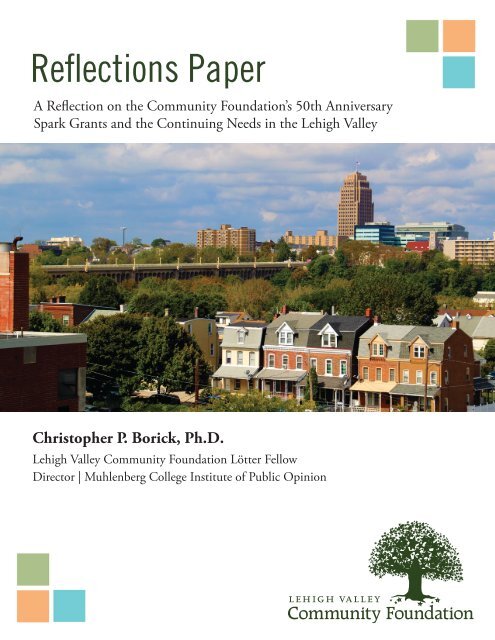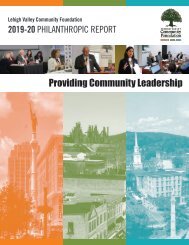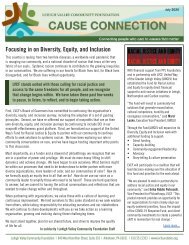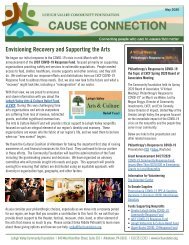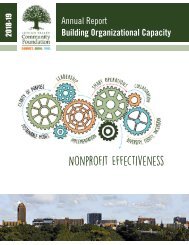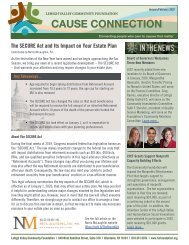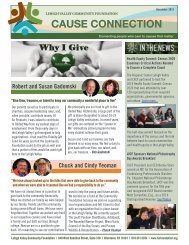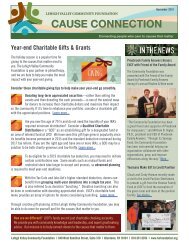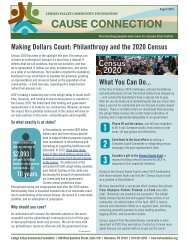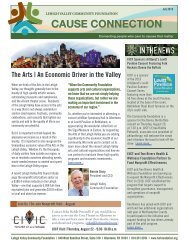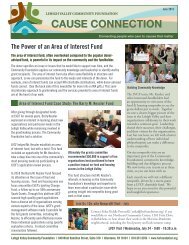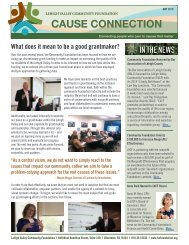LVCF Reflections Paper | 50th Anniversary Spark Grants and the Continuing Needs in the Lehigh Valley
A Reflection on the Community Foundation’s 50th Anniversary Spark Grants and the Continuing Needs in the Lehigh Valley
A Reflection on the Community Foundation’s 50th Anniversary
Spark Grants and the Continuing Needs in the Lehigh Valley
You also want an ePaper? Increase the reach of your titles
YUMPU automatically turns print PDFs into web optimized ePapers that Google loves.
<strong>Reflections</strong> <strong>Paper</strong><br />
A Reflection on <strong>the</strong> Community Foundation’s <strong>50th</strong> <strong>Anniversary</strong><br />
<strong>Spark</strong> <strong>Grants</strong> <strong>and</strong> <strong>the</strong> <strong>Cont<strong>in</strong>u<strong>in</strong>g</strong> <strong>Needs</strong> <strong>in</strong> <strong>the</strong> <strong>Lehigh</strong> <strong>Valley</strong><br />
Christopher P. Borick, Ph.D.<br />
<strong>Lehigh</strong> <strong>Valley</strong> Community Foundation Lötter Fellow<br />
Director | Muhlenberg College Institute of Public Op<strong>in</strong>ion
TABLE OF CONTENTS<br />
Lötter Fellow <strong>Reflections</strong> <strong>Paper</strong><br />
Christopher P. Borick, Ph.D.<br />
1<br />
Introduction<br />
3<br />
Mental <strong>and</strong> Behavioral Health<br />
7<br />
Cultural Enrichment<br />
11<br />
Food <strong>and</strong> Hous<strong>in</strong>g Access<br />
15<br />
Environment <strong>and</strong> Susta<strong>in</strong>ability<br />
19<br />
Human Traffick<strong>in</strong>g<br />
23<br />
Veterans Affairs<br />
27<br />
Conclusion
Introduction<br />
Much has changed <strong>in</strong> <strong>the</strong> <strong>Lehigh</strong> <strong>Valley</strong> s<strong>in</strong>ce <strong>the</strong> <strong>Lehigh</strong> <strong>Valley</strong> Community Foundation (<strong>LVCF</strong>)<br />
was founded <strong>in</strong> 1967 under its orig<strong>in</strong>al name of <strong>the</strong> Bethlehem Area Foundation. In <strong>the</strong> half<br />
century s<strong>in</strong>ce <strong>LVCF</strong> began its operations, <strong>the</strong> region has seen its population grow by nearly a quarter<br />
of a million people, its suburban areas boom <strong>and</strong> its urban areas struggle before experienc<strong>in</strong>g a<br />
renaissance <strong>in</strong> <strong>the</strong> 21st Century.<br />
few months of 2018, <strong>the</strong> Muhlenberg team reached out to <strong>Spark</strong> grant recipients to ascerta<strong>in</strong> <strong>the</strong>ir<br />
<strong>in</strong>sight on <strong>the</strong> experiences <strong>the</strong>y had as <strong>the</strong>ir organizations implemented <strong>the</strong> grants <strong>and</strong> to ga<strong>the</strong>r <strong>the</strong>ir<br />
perceptions on where <strong>the</strong> greatest rema<strong>in</strong><strong>in</strong>g needs are <strong>in</strong> <strong>the</strong>ir areas of <strong>in</strong>terest.<br />
In this paper, <strong>the</strong> Muhlenberg College Institute of Public Op<strong>in</strong>ion exam<strong>in</strong>es <strong>the</strong> six areas <strong>in</strong> which<br />
<strong>the</strong> <strong>Spark</strong> grants were directed through a three-part process:<br />
1st<br />
The report seeks to provide contextual perspective regard<strong>in</strong>g <strong>the</strong> six issue categories<br />
that were identified as <strong>the</strong> focus of <strong>the</strong> <strong>Spark</strong> grants. In <strong>the</strong>se sections of <strong>the</strong> study,<br />
<strong>the</strong> challenges are exam<strong>in</strong>ed <strong>in</strong> terms of national, state <strong>and</strong> local perspectives<br />
through both quantitative <strong>and</strong> qualitative measures.<br />
While <strong>the</strong> <strong>Lehigh</strong> <strong>Valley</strong> is flourish<strong>in</strong>g <strong>in</strong> many ways, it struggles with a number of <strong>the</strong> same<br />
challenges that are part of contemporary American life. The residents of <strong>Lehigh</strong> <strong>and</strong> Northampton<br />
counties face an array of social, economic <strong>and</strong> environmental issues with local governments <strong>and</strong><br />
nonprofits engaged <strong>in</strong> efforts to address <strong>the</strong>se concerns. As it has done for <strong>the</strong> past half-century,<br />
<strong>the</strong> <strong>Lehigh</strong> <strong>Valley</strong> Community Foundation has sought to assist <strong>the</strong>se local entities <strong>in</strong> meet<strong>in</strong>g <strong>the</strong><br />
challenges <strong>the</strong>y face <strong>and</strong> to thus meet <strong>the</strong> Foundation’s mission of “improv<strong>in</strong>g <strong>the</strong> quality of life <strong>in</strong><br />
our region.”<br />
To mark it’s <strong>50th</strong> year of operation, <strong>the</strong> <strong>Lehigh</strong> <strong>Valley</strong> Community Foundation sought to target a<br />
number of <strong>the</strong> most press<strong>in</strong>g issues related to <strong>the</strong> quality of life <strong>in</strong> <strong>the</strong> area through <strong>the</strong> establishment<br />
of its <strong>Spark</strong> grants <strong>in</strong>itiative. Under this <strong>in</strong>itiative, <strong>LVCF</strong> identified <strong>the</strong> follow<strong>in</strong>g issue areas as <strong>the</strong><br />
structural formation of <strong>the</strong> application <strong>and</strong> award process:<br />
2nd<br />
3rd<br />
The report exam<strong>in</strong>es <strong>the</strong> <strong>Spark</strong> grants <strong>and</strong> how <strong>the</strong> resources allocated are be<strong>in</strong>g<br />
used to address <strong>the</strong> underly<strong>in</strong>g problems identified <strong>in</strong> each issue area.<br />
The report turns to <strong>the</strong> most press<strong>in</strong>g needs that rema<strong>in</strong> <strong>in</strong> <strong>the</strong> wake of <strong>the</strong> <strong>Spark</strong><br />
sponsored efforts.<br />
• Mental & Behavioral Health<br />
• Cultural Enrichment<br />
• Food & Hous<strong>in</strong>g Access<br />
• Environment & Susta<strong>in</strong>ability<br />
• Human Traffick<strong>in</strong>g<br />
• Veterans Affairs<br />
Throughout 2017, <strong>LVCF</strong> awarded $50,000 <strong>in</strong> each of <strong>the</strong> six areas identified with 29 recipients<br />
receiv<strong>in</strong>g a <strong>Spark</strong> grant. These grants have been utilized by local agencies to support new <strong>in</strong>itiatives<br />
<strong>and</strong> enhance older programs that are engaged <strong>in</strong> improv<strong>in</strong>g <strong>the</strong> quality of life <strong>in</strong> <strong>the</strong> <strong>Lehigh</strong> <strong>Valley</strong><br />
with<strong>in</strong> <strong>the</strong> six issue realms identified as <strong>the</strong> target of <strong>the</strong> <strong>Spark</strong> grants program.<br />
To help better underst<strong>and</strong> <strong>the</strong> impact of <strong>the</strong> Community Foundation’s <strong>Spark</strong> grants <strong>in</strong>itiative<br />
<strong>and</strong> evaluate what <strong>the</strong> most press<strong>in</strong>g needs are <strong>in</strong> <strong>the</strong> issue areas identified, <strong>LVCF</strong> established Dr.<br />
Christopher P. Borick as its Lötter Fellow. The fellowship was made possible through a generous<br />
grant from <strong>the</strong> Lötter Family Fund, at <strong>the</strong> recommendation of Lu<strong>the</strong>r J. Hottle. In his capacity as <strong>the</strong><br />
Lötter Fellow, Dr. Borick, along with <strong>the</strong> students <strong>and</strong> staff of <strong>the</strong> Muhlenberg College Institute of<br />
Public Op<strong>in</strong>ion (MCIPO), engaged <strong>in</strong> an exam<strong>in</strong>ation of <strong>the</strong> particular challenges that <strong>the</strong> <strong>Lehigh</strong><br />
<strong>Valley</strong> is fac<strong>in</strong>g <strong>in</strong> <strong>the</strong> six areas addressed dur<strong>in</strong>g <strong>the</strong> <strong>Spark</strong> grants program.<br />
Beg<strong>in</strong>n<strong>in</strong>g <strong>in</strong> <strong>the</strong> fall of 2017, Dr. Borick <strong>and</strong> his students at <strong>the</strong> MCIPO ga<strong>the</strong>red contextual<br />
<strong>in</strong>formation regard<strong>in</strong>g <strong>the</strong> issues targeted by <strong>the</strong> <strong>Spark</strong> grants <strong>in</strong> an effort to more fully comprehend<br />
<strong>the</strong> challenges that are be<strong>in</strong>g faced by residents of <strong>the</strong> <strong>Lehigh</strong> <strong>Valley</strong>. This research helped build a<br />
framework <strong>in</strong> which local conditions are compared to national benchmarks <strong>and</strong> thus provide <strong>in</strong>sight<br />
<strong>in</strong>to some of <strong>the</strong> external pressures that are affect<strong>in</strong>g conditions <strong>in</strong> <strong>the</strong> <strong>Lehigh</strong> <strong>Valley</strong>. Over <strong>the</strong> first<br />
Through this process, we hope that <strong>LVCF</strong> <strong>Spark</strong> grants <strong>in</strong>itiative can be better understood <strong>in</strong> terms of its<br />
background, impact, <strong>and</strong> potential for fur<strong>the</strong>r action. The report certa<strong>in</strong>ly does not capture <strong>the</strong> nuance<br />
of <strong>the</strong> challenges that are fac<strong>in</strong>g <strong>the</strong> <strong>Lehigh</strong> <strong>Valley</strong> <strong>in</strong> <strong>the</strong> issue areas exam<strong>in</strong>ed, nor does it provide<br />
detailed <strong>in</strong>sight <strong>in</strong>to <strong>the</strong> tremendous work that <strong>the</strong> grant recipients are do<strong>in</strong>g to improve <strong>the</strong> quality of<br />
life <strong>in</strong> <strong>the</strong> region. Fur<strong>the</strong>rmore, <strong>the</strong> needs expressed <strong>in</strong> <strong>the</strong> “Next Steps” sections should, by no means,<br />
be considered exhaustive as <strong>the</strong>re are many salient needs that rema<strong>in</strong> unstated <strong>in</strong> <strong>the</strong> report. This paper<br />
should be read as a reflection on <strong>the</strong> challenges that are faced by residents of <strong>the</strong> <strong>Lehigh</strong> <strong>Valley</strong>, <strong>the</strong><br />
role that <strong>the</strong> <strong>Spark</strong> grants have played <strong>in</strong> address<strong>in</strong>g those challenges, <strong>and</strong> some perspective on what<br />
rema<strong>in</strong><strong>in</strong>g needs exist <strong>and</strong> potential steps to address<strong>in</strong>g <strong>the</strong>se issues.<br />
1 <strong>LVCF</strong> LÖTTER FELLOW REFLECTIONS PAPER <strong>LVCF</strong> LÖTTER FELLOW REFLECTIONS PAPER 2
Mental <strong>and</strong> Behavioral Health<br />
THE CONTEXT<br />
It is a crisis. The <strong>in</strong>crease <strong>in</strong> <strong>the</strong> prevalence of mental illness with<strong>in</strong> American society has become<br />
a def<strong>in</strong><strong>in</strong>g challenge for <strong>the</strong> nation as <strong>the</strong> United States moves deeper <strong>in</strong>to <strong>the</strong> 21st century. The<br />
statistics are stark, <strong>the</strong> personal narratives are wrench<strong>in</strong>g, <strong>and</strong> <strong>the</strong> range of mental health concerns is<br />
daunt<strong>in</strong>g.<br />
The factors beh<strong>in</strong>d <strong>the</strong> grow<strong>in</strong>g rates of mental illness <strong>in</strong> <strong>the</strong> United States are multi-faceted <strong>and</strong><br />
complex, <strong>and</strong> <strong>the</strong> breadth <strong>and</strong> effects of this epidemic are far reach<strong>in</strong>g. In 2017, it was estimated<br />
that 43 million or nearly 1 <strong>in</strong> 5 American adults have a mental health condition. In Pennsylvania<br />
alone over 1.8 million or 18.2% of <strong>the</strong> adult population are contend<strong>in</strong>g with a diagnosable mental,<br />
behavioral, or emotional disorder, o<strong>the</strong>r than a developmental or substance use disorder.<br />
The high levels of mental illness among <strong>the</strong> adult population <strong>in</strong> <strong>the</strong> United States have been<br />
accompanied by widespread prevalence of mental illness among <strong>the</strong> nation’s adolescents. Accord<strong>in</strong>g<br />
to <strong>the</strong> National Institutes of Health (NIH) approximately 1 <strong>in</strong> 5 (21.4%) of youth aged 13–18<br />
experiences a severe mental disorder at some po<strong>in</strong>t dur<strong>in</strong>g <strong>the</strong>ir life. For children aged 8–15, <strong>the</strong><br />
estimate is 13%. Perhaps most troubl<strong>in</strong>g are <strong>the</strong> <strong>in</strong>creas<strong>in</strong>g rates of mental illness among young<br />
Americans <strong>in</strong> recent years. For example, <strong>the</strong> rates of young people <strong>in</strong> <strong>the</strong> United States with severe<br />
depression <strong>in</strong>creased from 5.9% <strong>in</strong> 2012 to 8.2% <strong>in</strong> 2015.<br />
The soar<strong>in</strong>g rates of mental illness <strong>in</strong> <strong>the</strong> United States have stra<strong>in</strong>ed <strong>the</strong> capacity of mental health<br />
providers with access to mental health care not readily available to many Americans <strong>in</strong> need.<br />
Accord<strong>in</strong>g to <strong>the</strong> Kaiser Family Foundation, about 40% of mental health needs went unmet, <strong>and</strong><br />
due to an impend<strong>in</strong>g decl<strong>in</strong>e <strong>in</strong> <strong>the</strong> number of practic<strong>in</strong>g psychiatrists, a situation likely to worsen.<br />
As <strong>the</strong> number of young <strong>in</strong>dividuals with mental illness has <strong>in</strong>creased, The National Council Medical<br />
Director Institute <strong>in</strong>dicates that Pennsylvania has a severe shortage of practic<strong>in</strong>g child <strong>and</strong> adolescent<br />
psychiatrists. With <strong>the</strong> confluence of <strong>in</strong>creased mental health needs <strong>and</strong> a shortage of mental health<br />
professionals, <strong>in</strong>dividuals are <strong>in</strong>creas<strong>in</strong>gly turn<strong>in</strong>g to emergency rooms for care with visits to ERs<br />
<strong>in</strong>creas<strong>in</strong>g by more than 50% <strong>in</strong> <strong>the</strong> last decade for psychoses, bipolar disorders, depression, anxiety<br />
<strong>and</strong> stress reactions accord<strong>in</strong>g to <strong>the</strong> Healthcare Cost <strong>and</strong> Utilization Project.<br />
The above-mentioned factors have led to significant delays <strong>in</strong> treatment <strong>and</strong> dim<strong>in</strong>ished quality of<br />
mental health services. In <strong>the</strong> <strong>Lehigh</strong> <strong>Valley</strong>, wait<strong>in</strong>g lists to see psychiatrists <strong>and</strong> wait<strong>in</strong>g days <strong>in</strong><br />
hospitals for <strong>in</strong>patient beds to open are becom<strong>in</strong>g <strong>the</strong> norm <strong>and</strong> add<strong>in</strong>g to <strong>the</strong> mental health crisis<br />
that affects this <strong>and</strong> o<strong>the</strong>r regions.<br />
F<strong>in</strong>ally, <strong>the</strong> <strong>Lehigh</strong> <strong>Valley</strong> has felt a deep impact from <strong>the</strong> wide-rang<strong>in</strong>g hero<strong>in</strong> <strong>and</strong> opioid epidemic<br />
that has exploded <strong>in</strong> recent years. The effects of this epidemic are stagger<strong>in</strong>g with deaths from <strong>the</strong>se<br />
narcotics <strong>and</strong> o<strong>the</strong>r drugs <strong>in</strong>creas<strong>in</strong>g dramatically <strong>in</strong> recent years. Between 2016 <strong>and</strong> 2017, <strong>the</strong>re was<br />
a 25% <strong>in</strong>crease <strong>in</strong> drug-related fatalities <strong>in</strong> <strong>Lehigh</strong> County (197 deaths <strong>in</strong> 2017) <strong>and</strong> a 56% <strong>in</strong>crease<br />
<strong>in</strong> deaths caused by drugs <strong>in</strong> Northampton County (109 deaths <strong>in</strong> 2017) over <strong>the</strong> same period of<br />
time. A number of factors may be contribut<strong>in</strong>g to this spike <strong>in</strong> drug related deaths <strong>in</strong> <strong>the</strong> <strong>Lehigh</strong><br />
<strong>Valley</strong>, but <strong>the</strong> expansion of <strong>the</strong> use of Fentanyl, an extremely potent syn<strong>the</strong>tic opioid, appears to be<br />
contribut<strong>in</strong>g to <strong>the</strong> growth <strong>in</strong> drug overdose deaths.<br />
MENTAL AND BEHAVIORAL HEALTH SPARK GRANTS<br />
With grow<strong>in</strong>g challenges <strong>in</strong> <strong>the</strong> range <strong>and</strong> <strong>in</strong>tensity of mental illness <strong>in</strong> <strong>the</strong> <strong>Lehigh</strong> <strong>Valley</strong>, <strong>the</strong>re was<br />
no shortage of programs <strong>in</strong> need of support. Thus, <strong>the</strong> <strong>Spark</strong> grants targeted a range of aspects of<br />
this challeng<strong>in</strong>g issue.<br />
One enormous h<strong>in</strong>drance to effective treatment of mental illness is <strong>the</strong><br />
stigma that is still associated with <strong>the</strong>se medical conditions. Although<br />
<strong>the</strong>re has been considerable progress made <strong>in</strong> destigmatiz<strong>in</strong>g mental<br />
illness, many <strong>in</strong>dividuals fail to seek treatment for <strong>the</strong>ir afflictions out of<br />
concern about <strong>the</strong> perceptions of o<strong>the</strong>rs. To help familiarize local residents<br />
with <strong>the</strong> nature <strong>and</strong> reach of one of <strong>the</strong> most widespread mental illnesses,<br />
depression, a <strong>Spark</strong> grant was awarded to WLVT-TV PBS39 for production of a film entitled Close<br />
to Home: Depression. This film that premiered <strong>in</strong> May of 2017 explored <strong>the</strong> aspects of depression<br />
such as stigma, care <strong>and</strong> recovery <strong>in</strong> order to <strong>in</strong>spire those whose lives have been affected by this<br />
mental illness. As a representative from PBS39 noted, this documentary was designed to help<br />
“change <strong>the</strong> conversation to one of support <strong>and</strong> underst<strong>and</strong><strong>in</strong>g” about depression.<br />
Educat<strong>in</strong>g <strong>the</strong> public about mental health issues, <strong>and</strong> <strong>in</strong> particular<br />
younger <strong>in</strong>dividuals <strong>in</strong> <strong>the</strong> <strong>Lehigh</strong> <strong>Valley</strong>, was also <strong>the</strong> focus of a<br />
<strong>Spark</strong> grant awarded to Communities In Schools <strong>Lehigh</strong> <strong>Valley</strong><br />
for an <strong>in</strong>itiative called Student Voice to raise awareness of suicide<br />
prevention, healthy relationships, <strong>and</strong> elim<strong>in</strong>at<strong>in</strong>g drug <strong>and</strong> alcohol abuse. This <strong>in</strong>itiative reaches an<br />
array of local school districts with programm<strong>in</strong>g directed to a demographic that has been particularly<br />
hard hit by mental health challenges.<br />
In addition to support<strong>in</strong>g efforts to raise awareness<br />
<strong>and</strong> educate <strong>the</strong> public about mental illness, it is also<br />
important to highlight <strong>and</strong> celebrate <strong>the</strong> importance<br />
of recovery for those deal<strong>in</strong>g with addiction or o<strong>the</strong>r<br />
mental health issues. To this end a grant was awarded to Treatment Trends, Inc. for Rally <strong>in</strong> <strong>the</strong><br />
<strong>Valley</strong>: Car<strong>in</strong>g Across Communities. This annual event at Cedar Crest College focuses on elim<strong>in</strong>at<strong>in</strong>g<br />
barriers to recovery through a day of food, fun, music, speakers, <strong>and</strong> local vendors who jo<strong>in</strong> toge<strong>the</strong>r<br />
to role model unity <strong>in</strong> recovery.<br />
3 <strong>LVCF</strong> LÖTTER FELLOW REFLECTIONS PAPER <strong>LVCF</strong> LÖTTER FELLOW REFLECTIONS PAPER 4
Mental <strong>and</strong> Behavioral Health (cont<strong>in</strong>ued)<br />
Given <strong>the</strong> scope of mental health illnesses <strong>in</strong> <strong>the</strong> <strong>Lehigh</strong> <strong>Valley</strong>, <strong>the</strong> need<br />
for <strong>the</strong>rapy is extremely high. There are numerous <strong>the</strong>rapeutic options<br />
that are be<strong>in</strong>g employed for <strong>in</strong>dividuals deal<strong>in</strong>g with mental illness,<br />
but for certa<strong>in</strong> populations some alternatives have proven particularly<br />
productive. One approach that has proven to be very effective is us<strong>in</strong>g<br />
animals as part of <strong>the</strong>rapeutic treatment. A <strong>Spark</strong> grant was awarded to<br />
Equi-librium for <strong>the</strong>ir “A New Path” program. A New Path provides<br />
<strong>the</strong>rapy utiliz<strong>in</strong>g horses to participants from all backgrounds, with<br />
vary<strong>in</strong>g degrees of cognitive, physical, behavioral, psychological or<br />
sensory disabilities.<br />
While provid<strong>in</strong>g <strong>the</strong>rapy to <strong>in</strong>dividuals is central <strong>in</strong> <strong>the</strong> broader effort to confront<br />
mental illness, <strong>the</strong> effects of this epidemic on <strong>the</strong> family <strong>and</strong> friends of those<br />
afflicted with mental health challenges are often overwhelm<strong>in</strong>g. Support services<br />
are <strong>in</strong> essence necessary for <strong>the</strong> family <strong>and</strong> friends that are support<strong>in</strong>g those with<br />
mental illnesses. A <strong>Spark</strong> grant was awarded to Haven House to aid <strong>the</strong>ir support<br />
group for family <strong>and</strong> friends of <strong>in</strong>carcerated or released prisoners with mental<br />
illness.<br />
NEXT STEPS<br />
To address <strong>the</strong> exp<strong>and</strong><strong>in</strong>g mental health <strong>and</strong> opioid crises <strong>in</strong> <strong>the</strong> <strong>Lehigh</strong> <strong>Valley</strong>, it will require<br />
significant public <strong>and</strong> private efforts. These issues have grown <strong>in</strong>to some of <strong>the</strong> most complex<br />
<strong>and</strong> widespread public health crises <strong>in</strong> a generation <strong>and</strong> are enormous challenges for <strong>the</strong> region to<br />
confront. From <strong>the</strong> overview of <strong>the</strong> issue presented earlier <strong>in</strong> this section, it is clear that <strong>the</strong>re are<br />
many areas of need but some priorities appear to have emerged.<br />
Support for Juvenile Mental Health Care<br />
While <strong>the</strong> prevalence of mental health illness <strong>in</strong> <strong>the</strong> <strong>Lehigh</strong> <strong>Valley</strong> is<br />
significant across all age groups, <strong>the</strong> <strong>in</strong>crease <strong>in</strong> mental illness among<br />
juveniles is particularly notable <strong>and</strong> worthy of significant immediate<br />
attention. The shortage of mental health professionals that serve child<br />
<strong>and</strong> adolescent populations underm<strong>in</strong>es <strong>the</strong> ability of <strong>the</strong> region to<br />
meet <strong>the</strong> grow<strong>in</strong>g needs of <strong>the</strong> <strong>Lehigh</strong> <strong>Valley</strong>’s youngest residents. Local schools are at<br />
<strong>the</strong> center of <strong>in</strong>creas<strong>in</strong>g mental health challenges with<strong>in</strong> <strong>the</strong>ir student populations <strong>and</strong><br />
stra<strong>in</strong>ed capacity to meet <strong>the</strong>se student needs. Given already limited budgetary resources,<br />
schools are becom<strong>in</strong>g overwhelmed by <strong>the</strong> mental health service pressures <strong>and</strong> thus<br />
support to <strong>the</strong>se education entities is badly needed. Beyond schools, <strong>the</strong> <strong>Lehigh</strong> <strong>Valley</strong>’s<br />
nonprofit organizations serv<strong>in</strong>g child <strong>and</strong> adolescent populations need to build <strong>in</strong>creased<br />
capacity <strong>and</strong> expertise as dem<strong>and</strong>s for <strong>the</strong>ir services grow <strong>and</strong> <strong>the</strong>refore require additional<br />
community support.<br />
Build on Mental Illness Destigmatiz<strong>in</strong>g Efforts<br />
Despite much progress over recent decades <strong>in</strong> destigmatiz<strong>in</strong>g mental<br />
illness <strong>the</strong>re rema<strong>in</strong> significant psychological barriers that prevent<br />
<strong>in</strong>dividuals from seek<strong>in</strong>g help. Recent efforts by local entities such as<br />
PBS39 to build awareness about mental illness <strong>in</strong> <strong>the</strong> local community<br />
are essential <strong>in</strong> erod<strong>in</strong>g <strong>the</strong> stigma that rema<strong>in</strong>s associated with mental<br />
conditions. Research has shown that social contact is an effective type<br />
of <strong>in</strong>tervention to improve stigma-related knowledge <strong>and</strong> attitudes. The development<br />
<strong>and</strong> enhancement of local programs that connect those with <strong>and</strong> without mental illness<br />
would be beneficial <strong>in</strong> fur<strong>the</strong>r break<strong>in</strong>g down exist<strong>in</strong>g stigma related to mental illness.<br />
Mental health literacy campaigns that have focused on how to encourage <strong>in</strong>dividuals <strong>and</strong><br />
families to seek needed services have been effective <strong>in</strong> dim<strong>in</strong>ish<strong>in</strong>g stigma with<strong>in</strong> select<br />
populations <strong>and</strong> should be supported <strong>and</strong> exp<strong>and</strong>ed <strong>in</strong> <strong>the</strong> region.<br />
Build<strong>in</strong>g Treatment Capacity for Mental Health <strong>and</strong> Drug<br />
Addiction<br />
The <strong>Lehigh</strong> <strong>Valley</strong>, like many areas across <strong>the</strong> United States, is<br />
experienc<strong>in</strong>g a sizable shortage of mental health professionals. This<br />
shortage requires both longer-term efforts to tra<strong>in</strong> mental health<br />
professionals <strong>and</strong> shorter-term <strong>in</strong>itiatives to maximize <strong>the</strong> efficiency<br />
<strong>and</strong> effectiveness of <strong>the</strong> region’s mental health care capacity. Local<br />
educational <strong>and</strong> health care organizations have <strong>in</strong>creased efforts to tra<strong>in</strong><br />
<strong>and</strong> attract mental health professionals to <strong>the</strong> <strong>Lehigh</strong> <strong>Valley</strong> <strong>and</strong> such <strong>in</strong>itiatives should<br />
be supported. But <strong>in</strong> <strong>the</strong> short term, local mental health treatment providers need<br />
immediate support to stabilize <strong>and</strong> enhance <strong>the</strong> services that are available to <strong>the</strong> grow<strong>in</strong>g<br />
number of <strong>Valley</strong> residents experienc<strong>in</strong>g mental health challenges.<br />
There is also a severe shortage of health centers <strong>in</strong> <strong>the</strong> <strong>Lehigh</strong> <strong>Valley</strong> that provide<br />
comprehensive treatment options for drug addiction. One such center <strong>in</strong> <strong>the</strong> region<br />
embrac<strong>in</strong>g a medication-assisted treatment program is <strong>the</strong> Neighborhood Health<br />
Centers of <strong>the</strong> <strong>Lehigh</strong> <strong>Valley</strong> (NHCLV). At this Center, clients are provided with<br />
access to primary care, mental health counsel<strong>in</strong>g <strong>and</strong> coord<strong>in</strong>ated drug counsel<strong>in</strong>g, <strong>and</strong><br />
rehabilitation programs with o<strong>the</strong>r providers. As NHCLV Chief Medical Officer Tim<br />
Daly recently told The Morn<strong>in</strong>g Call, “Case managers make sure people who have no<br />
car get to <strong>the</strong>ir appo<strong>in</strong>tments” <strong>and</strong> “also go to court or hous<strong>in</strong>g hear<strong>in</strong>g with clients.”<br />
He added, “That’s <strong>the</strong> stuff that make treatments work <strong>and</strong> builds relationships.” The<br />
expansion of such comprehensive treatment options such as <strong>the</strong> NHCLV should be a<br />
priority for <strong>the</strong> <strong>Lehigh</strong> <strong>Valley</strong> community as part of <strong>the</strong> overall effort to confront <strong>the</strong><br />
opioid epidemic.<br />
5 <strong>LVCF</strong> LÖTTER FELLOW REFLECTIONS PAPER <strong>LVCF</strong> LÖTTER FELLOW REFLECTIONS PAPER 6
Cultural Enrichment<br />
THE CONTEXT<br />
Quality of life <strong>in</strong> a region is often associated with fundamental economic, environmental <strong>and</strong><br />
health factors. While measures such as median <strong>in</strong>come <strong>and</strong> life expectancy may <strong>in</strong>dicate important<br />
<strong>in</strong>formation about <strong>the</strong> condition of a community, <strong>the</strong>se metrics cannot fully capture <strong>the</strong> vibrancy of<br />
life <strong>in</strong> an area. That’s because quality of life <strong>in</strong> a community rests not only on how long its residents<br />
live but also on how <strong>the</strong>y live. This is where access to <strong>the</strong> arts is crucial. When <strong>the</strong> arts are fully<br />
<strong>in</strong>tegrated <strong>in</strong>to a region, <strong>the</strong> lives of citizens are enriched for <strong>the</strong> arts br<strong>in</strong>g <strong>in</strong>dividuals toge<strong>the</strong>r <strong>and</strong><br />
foster community. As novelist Marcel Proust said, “Only through art can we get outside of ourselves<br />
<strong>and</strong> know ano<strong>the</strong>r’s view of <strong>the</strong> universe.”<br />
For a region <strong>the</strong> size of <strong>the</strong> <strong>Lehigh</strong> <strong>Valley</strong>, <strong>the</strong> arts have an exceptional presence <strong>in</strong> <strong>the</strong> community.<br />
With high quality artistic venues, outst<strong>and</strong><strong>in</strong>g museums <strong>and</strong> symphonies, <strong>and</strong> a vibrant <strong>the</strong>ater<br />
scene, <strong>the</strong> <strong>Lehigh</strong> <strong>Valley</strong> provides its residents with access to <strong>the</strong> arts <strong>in</strong> a way that is not available to<br />
most similarly sized areas.<br />
Yet ma<strong>in</strong>ta<strong>in</strong><strong>in</strong>g <strong>and</strong> enhanc<strong>in</strong>g <strong>the</strong> arts <strong>in</strong> <strong>the</strong> <strong>Lehigh</strong> <strong>Valley</strong> is not without its challenges. As with<br />
many o<strong>the</strong>r communities, access to <strong>the</strong> arts with<strong>in</strong> <strong>the</strong> region is not always readily available to all of<br />
its residents. Socio-economic, cultural <strong>and</strong> geographic factors may <strong>in</strong>hibit a significant number of<br />
<strong>in</strong>dividuals with<strong>in</strong> <strong>Lehigh</strong> <strong>and</strong> Northampton counties from utiliz<strong>in</strong>g many of <strong>the</strong> exist<strong>in</strong>g arts assets<br />
of <strong>the</strong> region or from develop<strong>in</strong>g artistic resources that may be most desired by certa<strong>in</strong> communities.<br />
There also appears to be a grow<strong>in</strong>g concern that <strong>the</strong> <strong>Lehigh</strong> <strong>Valley</strong>’s vibrant nonprofit arts community<br />
is feel<strong>in</strong>g negative impacts from <strong>the</strong> major expansion of for-profit arts <strong>and</strong> enterta<strong>in</strong>ment venues<br />
throughout <strong>the</strong> area. A recent study from a Wash<strong>in</strong>gton D.C. based arts advocacy group, Americans<br />
for <strong>the</strong> Arts, found that <strong>the</strong> annual economic activity generated by <strong>the</strong> <strong>Lehigh</strong> <strong>Valley</strong>’s nonprofit arts<br />
<strong>and</strong> culture <strong>in</strong>dustry was down about 11% over <strong>the</strong> past five years. In addition, <strong>the</strong> <strong>Lehigh</strong> <strong>Valley</strong><br />
Arts Council reports that attendance at nonprofit arts events dropped 30% between 2012 <strong>and</strong> 2017.<br />
While <strong>the</strong>se drops <strong>in</strong> attendance <strong>and</strong> economic activity among nonprofit arts organizations may be<br />
affected by numerous factors, <strong>the</strong> high levels of attendance at for-profit venues is likely cutt<strong>in</strong>g <strong>in</strong>to<br />
dem<strong>and</strong> for nonprofit arts events.<br />
SPARK GRANTS FOR CULTURAL ENRICHMENT<br />
The desire to exp<strong>and</strong> access <strong>and</strong> programs, while promot<strong>in</strong>g <strong>the</strong> arts were major thrusts of <strong>the</strong> <strong>Spark</strong><br />
grants distributed with<strong>in</strong> this category of <strong>the</strong> broader <strong>in</strong>itiative. Inclusion of residents who have<br />
faced a variety of impediments more fully <strong>in</strong>to <strong>the</strong> arts can be seen <strong>in</strong> <strong>the</strong> range of awards to arts <strong>and</strong><br />
cultural entities <strong>in</strong> <strong>the</strong> <strong>Lehigh</strong> <strong>Valley</strong>.<br />
The historic State Theatre <strong>in</strong> Easton is a premiere venue <strong>in</strong> <strong>the</strong><br />
<strong>Lehigh</strong> <strong>Valley</strong> <strong>and</strong> home to an array of live musical <strong>and</strong> <strong>the</strong>ater<br />
performances each year, <strong>in</strong>clud<strong>in</strong>g The FREDDY© Awards, each<br />
May. While thous<strong>and</strong>s visit <strong>the</strong> State Theatre each year, access for<br />
many local residents is limited because of f<strong>in</strong>ancial barriers. As<br />
a representative of <strong>the</strong> Theater told us, “There are many who would love to come that do not have<br />
<strong>the</strong> resources to purchase tickets for our events.” Given this dynamic a <strong>Spark</strong> grant was awarded to<br />
<strong>the</strong> State Theatre Center for <strong>the</strong> Arts, Inc., to underwrite <strong>the</strong> cost of tickets for select FREDDY<br />
student populations (<strong>and</strong> o<strong>the</strong>r students) as well as for local veterans to certa<strong>in</strong> Broadway <strong>and</strong> o<strong>the</strong>r<br />
performances at <strong>the</strong> State Theatre dur<strong>in</strong>g <strong>the</strong> 2017-2018 show season.<br />
While access to <strong>the</strong> arts may be constra<strong>in</strong>ed by economic forces,<br />
o<strong>the</strong>r factors may limit <strong>in</strong>dividual <strong>in</strong>clusion with<strong>in</strong> <strong>the</strong> community.<br />
Historically, disabled <strong>in</strong>dividuals have faced a number of barriers<br />
that have prevented <strong>the</strong>m from be<strong>in</strong>g fully engaged <strong>in</strong> various<br />
aspects of life <strong>in</strong> <strong>the</strong> region. Break<strong>in</strong>g down those barriers has been<br />
a focus of disability advocacy groups <strong>and</strong> <strong>the</strong> <strong>in</strong>spiration beh<strong>in</strong>d an <strong>in</strong>novative effort receiv<strong>in</strong>g a<br />
<strong>Spark</strong> grant. Mikayla’s Voice received fund<strong>in</strong>g for <strong>the</strong>ir Our Friend Brady program that enabled <strong>the</strong><br />
organization to produce a book on what it is like to be friends with someone with a disability <strong>and</strong><br />
serve as a catalyst for fur<strong>the</strong>r discussion about this topic. Brady, a disabled student at Spr<strong>in</strong>g Garden<br />
Elementary School <strong>in</strong> Bethlehem Pa., <strong>and</strong> his friends tell <strong>the</strong>ir story of friendship <strong>in</strong> <strong>the</strong> book that<br />
was donated to 3rd, 4th <strong>and</strong> 5th grade classrooms <strong>in</strong> <strong>the</strong> <strong>Lehigh</strong> <strong>Valley</strong> <strong>and</strong> across Pennsylvania.<br />
Tell<strong>in</strong>g <strong>the</strong> stories of <strong>the</strong> <strong>Lehigh</strong> <strong>Valley</strong> <strong>and</strong> its people is a<br />
very important function of <strong>the</strong> arts community <strong>in</strong> <strong>the</strong> region.<br />
A <strong>Spark</strong> grant was awarded to The National Museum of<br />
Industrial History to help <strong>in</strong> <strong>the</strong> development of The<br />
Cab<strong>in</strong>et of Curiosity, an <strong>in</strong>teractive exhibit <strong>in</strong> <strong>the</strong> Museum’s Iron <strong>and</strong> Steel Gallery. This exhibit<br />
focuses on <strong>the</strong> <strong>in</strong>dividuals, families <strong>and</strong> communities from fifty foreign countries who were drawn to<br />
South Bethlehem to work at <strong>the</strong> Bethlehem Steel plant.<br />
In a similar ve<strong>in</strong>, a <strong>Spark</strong> grant was provided to ArtsQuest, Inc. for<br />
<strong>the</strong>ir Art<strong>Spark</strong>s project that is a new <strong>in</strong>itiative that highlights <strong>the</strong> rich<br />
<strong>and</strong> diverse cultures that make up <strong>the</strong> Greater <strong>Lehigh</strong> <strong>Valley</strong> through<br />
<strong>the</strong> presentation of arts <strong>and</strong> culture programs at SteelStacks <strong>and</strong> <strong>the</strong> Banana Factory.<br />
F<strong>in</strong>ally, live music events are a cornerstone of <strong>the</strong> <strong>Lehigh</strong><br />
<strong>Valley</strong> arts scene <strong>and</strong> an important venue for br<strong>in</strong>g<strong>in</strong>g<br />
diverse sections of <strong>the</strong> community around shared <strong>in</strong>terests.<br />
Jazz has a particularly strong history of bridg<strong>in</strong>g racial,<br />
ethnic <strong>and</strong> economic l<strong>in</strong>es <strong>and</strong> thus a <strong>Spark</strong> grant was awarded to Perform<strong>in</strong>g Arts Live, Inc. to<br />
support <strong>the</strong> 2017 edition of Allentown JazzFest that took place <strong>in</strong> May 2017.<br />
7 <strong>LVCF</strong> LÖTTER FELLOW REFLECTIONS PAPER <strong>LVCF</strong> LÖTTER FELLOW REFLECTIONS PAPER 8
Cultural Enrichment (cont<strong>in</strong>ued)<br />
NEXT STEPS<br />
As noted earlier <strong>in</strong> this section, <strong>the</strong> <strong>Lehigh</strong> <strong>Valley</strong> has a tremendously vibrant arts community that<br />
enriches <strong>the</strong> quality of life for <strong>the</strong> residents of Northampton <strong>and</strong> <strong>Lehigh</strong> counties. However, <strong>the</strong><br />
ability of <strong>the</strong> arts to reach <strong>the</strong> full range of local residents <strong>and</strong> communities is precluded by a number<br />
of barriers that require strong <strong>and</strong> prolonged efforts to overcome.<br />
Access to <strong>the</strong> Arts<br />
For <strong>the</strong> arts to fully enrich <strong>the</strong> quality of life with<strong>in</strong> <strong>the</strong> <strong>Lehigh</strong> <strong>Valley</strong>,<br />
it is necessary that all of its residents have access to <strong>the</strong>se community<br />
assets. However economic factors regularly limit <strong>the</strong> ability of many<br />
of <strong>the</strong> region’s citizens from engag<strong>in</strong>g <strong>in</strong> <strong>the</strong> arts <strong>in</strong> substantial <strong>and</strong><br />
mean<strong>in</strong>gful ways. While many artistic entities <strong>in</strong> <strong>the</strong> <strong>Valley</strong> would<br />
like to provide enhanced access to <strong>the</strong>ir productions to economically<br />
challenged populations, <strong>the</strong> arts organizations need for ticket revenue places <strong>the</strong>m <strong>in</strong> a<br />
difficult situation. As a representative for <strong>the</strong> State Theatre told us, “Given that tickets<br />
are one of our ma<strong>in</strong> revenue sources, we just can’t accommodate as many economically<br />
disadvantaged <strong>in</strong>dividuals as we’d like.” Therefore, it is essential that <strong>the</strong> community<br />
cont<strong>in</strong>ue to offer support to arts venues to allow <strong>the</strong>se entities <strong>the</strong> f<strong>in</strong>ancial capabilities to<br />
serve lower <strong>in</strong>come residents of <strong>the</strong> region.<br />
F<strong>in</strong>d<strong>in</strong>g Balance Between <strong>the</strong> For-profit <strong>and</strong><br />
Nonprofit Arts Sectors<br />
The arrival <strong>and</strong> growth of major arts <strong>and</strong> enterta<strong>in</strong>ment venues such as<br />
<strong>the</strong> PPL Center <strong>and</strong> <strong>the</strong> S<strong>and</strong>s Events Center have certa<strong>in</strong>ly provided<br />
<strong>Lehigh</strong> <strong>Valley</strong> residents with an array of popular enterta<strong>in</strong>ment options.<br />
While <strong>the</strong> <strong>Lehigh</strong> <strong>Valley</strong> community benefits from <strong>the</strong> presence of <strong>the</strong>se<br />
new venues, <strong>the</strong> impact on exist<strong>in</strong>g nonprofit arts <strong>and</strong> cultural entities<br />
may be negative with patrons substitut<strong>in</strong>g events at for-profit venues for<br />
those at nonprofit locations. Therefore, it is necessary to explore options <strong>in</strong> which forprofit<br />
<strong>and</strong> nonprofit arts entities complement each o<strong>the</strong>r’s offer<strong>in</strong>g ra<strong>the</strong>r than substitut<strong>in</strong>g<br />
one for <strong>the</strong> o<strong>the</strong>r. Among <strong>the</strong> options that create such a positive dynamic are <strong>in</strong>creased<br />
efforts to attract more patrons from outside <strong>the</strong> region to local nonprofit arts events <strong>and</strong><br />
to create more direct coord<strong>in</strong>ation <strong>and</strong> cooperation between <strong>the</strong> arts sectors with<strong>in</strong> <strong>the</strong><br />
<strong>Valley</strong>. One such possibility that was recently suggested by a representative of <strong>the</strong> <strong>Lehigh</strong><br />
<strong>Valley</strong> Arts Council, was for <strong>the</strong> creation of a regional “bus<strong>in</strong>ess-arts coalition, which<br />
would <strong>in</strong>clude professionals work<strong>in</strong>g toward a common goal — keep<strong>in</strong>g <strong>the</strong> nonprofit arts<br />
alive.” Such an effort seems well justified <strong>and</strong> worthy of support from <strong>the</strong> <strong>Lehigh</strong> <strong>Valley</strong><br />
community.<br />
Support<strong>in</strong>g Educational Programs <strong>in</strong> <strong>the</strong> Arts<br />
A major challenge for public schools is <strong>the</strong> difficulty of ma<strong>in</strong>ta<strong>in</strong><strong>in</strong>g<br />
appropriate fund<strong>in</strong>g levels for programs <strong>in</strong> <strong>the</strong> arts. The fiscal challenges<br />
that many school districts face with<strong>in</strong> <strong>the</strong> <strong>Lehigh</strong> <strong>Valley</strong> have taken<br />
its toll on a number of programs. School officials almost universally<br />
recognize <strong>the</strong> value that <strong>the</strong> arts br<strong>in</strong>g to students, but many are<br />
unable to secure <strong>the</strong> f<strong>in</strong>ancial resources necessary to ma<strong>in</strong>ta<strong>in</strong> programs<br />
<strong>in</strong> <strong>the</strong> arts. This scenario is more common <strong>in</strong> <strong>the</strong> <strong>Lehigh</strong> <strong>Valley</strong>’s most economically<br />
disadvantaged school districts where fiscal shortfalls have forced adm<strong>in</strong>istrators to reduce<br />
<strong>the</strong> number of offer<strong>in</strong>gs <strong>in</strong> <strong>the</strong> arts. Cuts to <strong>the</strong> arts <strong>in</strong> less wealthy districts are particularly<br />
problematic because for many students com<strong>in</strong>g from impoverished backgrounds, courses<br />
<strong>and</strong> programs <strong>in</strong> <strong>the</strong> arts provide creative opportunities that engage <strong>the</strong> students <strong>in</strong> school<br />
<strong>and</strong> help <strong>the</strong>m f<strong>in</strong>d greater success <strong>in</strong> core academic subjects. Thus, it is important that <strong>the</strong><br />
<strong>Lehigh</strong> <strong>Valley</strong> community f<strong>in</strong>d ways to assure that all students have access to <strong>the</strong> arts as<br />
part of <strong>the</strong>ir educational experiences.<br />
9 <strong>LVCF</strong> LÖTTER FELLOW REFLECTIONS PAPER <strong>LVCF</strong> LÖTTER FELLOW REFLECTIONS PAPER 10
Food <strong>and</strong> Hous<strong>in</strong>g Access<br />
THE CONTEXT<br />
They are <strong>the</strong> basics of life <strong>and</strong> <strong>in</strong> <strong>the</strong> <strong>Lehigh</strong> <strong>Valley</strong>, not always as available as one might commonly<br />
believe. Food <strong>and</strong> hous<strong>in</strong>g are daily challenges for thous<strong>and</strong>s of <strong>in</strong>dividuals liv<strong>in</strong>g <strong>in</strong> Northampton<br />
<strong>and</strong> <strong>Lehigh</strong> counties <strong>and</strong> <strong>the</strong> struggles to secure <strong>the</strong>se essentials consume much of <strong>the</strong> time <strong>and</strong> effort<br />
of many local residents.<br />
Food <strong>in</strong>security is def<strong>in</strong>ed as <strong>the</strong> state of be<strong>in</strong>g without reliable access to a sufficient quantity of<br />
affordable nutritious food. Approximately 1 <strong>in</strong> 10 residents of <strong>the</strong> <strong>Lehigh</strong> <strong>Valley</strong> live under such<br />
conditions. For local children, food <strong>in</strong>security is even more prevalent with 1 <strong>in</strong> 3 children <strong>in</strong> <strong>the</strong><br />
<strong>Valley</strong> regularly deal<strong>in</strong>g with hunger related conditions.<br />
While access to quality food items is highly related to <strong>the</strong> economic limitations of local residents,<br />
<strong>the</strong> dynamics of food <strong>in</strong>security <strong>in</strong> <strong>the</strong> <strong>Lehigh</strong> <strong>Valley</strong> are quite complex. One major contributor<br />
to <strong>the</strong> prom<strong>in</strong>ence of food <strong>in</strong>security with<strong>in</strong> <strong>Lehigh</strong> <strong>and</strong> Northampton counties is <strong>the</strong> presence<br />
of “food deserts” with<strong>in</strong> <strong>the</strong> region. A food desert is a geographic area where residents’ access to<br />
affordable, healthy food options such as fresh fruits <strong>and</strong> vegetables is very limited or miss<strong>in</strong>g due to<br />
<strong>the</strong> absence of grocery stores with<strong>in</strong> convenient travel<strong>in</strong>g distance. Accord<strong>in</strong>g to <strong>the</strong> United Way of<br />
<strong>the</strong> Greater <strong>Lehigh</strong> <strong>Valley</strong>, as of 2016, <strong>the</strong>re were eight food deserts <strong>in</strong> <strong>the</strong> region <strong>and</strong> 20 additional<br />
neighborhoods where residents needed to travel over half a mile to a grocery store. For <strong>in</strong>dividuals<br />
without affordable or reliable transportation, <strong>the</strong> distance to grocery stores often limits food options<br />
to costly convenient stores or fast food restaurants.<br />
The significant challenges for many <strong>Lehigh</strong> <strong>Valley</strong> residents that are posed by food <strong>in</strong>security are<br />
exacerbated by struggles <strong>in</strong> f<strong>in</strong>d<strong>in</strong>g affordable quality hous<strong>in</strong>g. While many aspects of <strong>the</strong> hous<strong>in</strong>g<br />
market such as home values <strong>and</strong> new hous<strong>in</strong>g construction have improved <strong>in</strong> <strong>the</strong> wake of <strong>the</strong><br />
Great Recession, <strong>the</strong> ability of a significant portion of <strong>the</strong> local population to acquire <strong>and</strong> ma<strong>in</strong>ta<strong>in</strong><br />
adequate hous<strong>in</strong>g rema<strong>in</strong>s very limited.<br />
The affordable hous<strong>in</strong>g challenges that are present <strong>in</strong> <strong>the</strong> <strong>Lehigh</strong> <strong>Valley</strong> have contributed to <strong>the</strong><br />
substantial number of local residents that are liv<strong>in</strong>g <strong>in</strong> subst<strong>and</strong>ard hous<strong>in</strong>g. Accord<strong>in</strong>g to <strong>the</strong><br />
United States Census Bureau, over 1 out of 3 hous<strong>in</strong>g units that are occupied <strong>in</strong> <strong>the</strong> <strong>Lehigh</strong> <strong>Valley</strong><br />
have one or more significant problems <strong>in</strong>clud<strong>in</strong>g overcrowd<strong>in</strong>g, subst<strong>and</strong>ard or non-function<strong>in</strong>g<br />
plumb<strong>in</strong>g or repair costs that are beyond <strong>the</strong> ability of <strong>the</strong> occupants to ma<strong>in</strong>ta<strong>in</strong>.<br />
At its most extreme level, <strong>the</strong> hous<strong>in</strong>g challenges <strong>in</strong> <strong>the</strong> <strong>Lehigh</strong> <strong>Valley</strong> manifest <strong>in</strong> <strong>in</strong>dividuals<br />
utiliz<strong>in</strong>g shelters (when available) for <strong>the</strong>ir hous<strong>in</strong>g needs or ultimately becom<strong>in</strong>g homeless.<br />
Accord<strong>in</strong>g to <strong>the</strong> Third Street Alliance <strong>in</strong> Easton, <strong>the</strong>re were over 500 households wait<strong>in</strong>g for shelter<br />
space or hous<strong>in</strong>g to open up dur<strong>in</strong>g 2017, with over 1,300 <strong>in</strong>dividuals homeless dur<strong>in</strong>g <strong>the</strong> same<br />
period of time.<br />
THE SPARK GRANTS FOR FOOD AND HOUSING ACCESS<br />
The food <strong>in</strong>security <strong>and</strong> affordable hous<strong>in</strong>g situations <strong>in</strong> <strong>the</strong> <strong>Lehigh</strong> <strong>Valley</strong> are among <strong>the</strong> most<br />
significant <strong>and</strong> difficult challenges that face <strong>the</strong> community at this time. The situation <strong>in</strong> <strong>the</strong>se areas<br />
requires significant short-term efforts to feed <strong>and</strong> house <strong>the</strong> <strong>Valley</strong>’s most vulnerable populations<br />
as <strong>the</strong>y seek to meet <strong>the</strong>ir immediate needs, while also look<strong>in</strong>g for longer term options to address<br />
<strong>the</strong> chronic aspects of food <strong>and</strong> shelter availability <strong>in</strong> <strong>the</strong> region. The <strong>Spark</strong> grants with<strong>in</strong> this realm<br />
were focused ma<strong>in</strong>ly on programs that are attempt<strong>in</strong>g to meet <strong>the</strong> tremendous daily needs of <strong>Lehigh</strong><br />
<strong>Valley</strong> residents as <strong>the</strong>y strive to secure food <strong>and</strong> hous<strong>in</strong>g for <strong>the</strong>mselves <strong>and</strong> <strong>the</strong>ir families.<br />
New Bethany M<strong>in</strong>istries <strong>in</strong> Bethlehem is among <strong>the</strong> largest providers of food to<br />
<strong>the</strong> <strong>Lehigh</strong> <strong>Valley</strong> residents struggl<strong>in</strong>g with food <strong>in</strong>security, reach<strong>in</strong>g over 6,000<br />
people annually with <strong>the</strong>ir services. Like many local social service organizations,<br />
New Bethany is fac<strong>in</strong>g capacity limits, <strong>and</strong> <strong>in</strong> particular with <strong>the</strong> size <strong>and</strong><br />
capabilities of its physical space. In order to meet <strong>the</strong> exp<strong>and</strong><strong>in</strong>g needs for its<br />
food distribution efforts, New Bethany is develop<strong>in</strong>g a new pantry. To assist with<br />
this effort, a <strong>Spark</strong> grant was awarded to this pivotal local organization.<br />
Th eSchool Sisters of Sa<strong>in</strong>t Francis <strong>in</strong> Bethlehem have a<br />
long history of provid<strong>in</strong>g assistance to those <strong>in</strong> need <strong>in</strong>clud<strong>in</strong>g<br />
those with food needs. Their goals <strong>in</strong>clude exp<strong>and</strong><strong>in</strong>g efforts<br />
to feed<strong>in</strong>g <strong>the</strong> hungry while car<strong>in</strong>g for <strong>the</strong> Earth, <strong>and</strong> build<strong>in</strong>g<br />
health communities. A <strong>Spark</strong> grant was directed to support <strong>the</strong> Monocacy Farm Project that supplies<br />
fresh fruit <strong>and</strong> vegetables to area organizations serv<strong>in</strong>g <strong>the</strong> hungry.<br />
While <strong>the</strong>re are important federal <strong>and</strong> state programs that help provide resources for<br />
<strong>in</strong>dividuals with lower <strong>in</strong>come to purchase food, <strong>the</strong> presence of food deserts often<br />
limits <strong>the</strong> type of food that can be bought. In particular, fresh produce <strong>and</strong> healthy<br />
foods may not be accessible to many <strong>in</strong>dividuals that receive benefits through<br />
programs such as <strong>the</strong> Supplemental Nutrition Assistance Program (SNAP). To help<br />
address this situation, a <strong>Spark</strong> grant was awarded to <strong>the</strong> Nurture Nature Center <strong>in</strong><br />
Easton to exp<strong>and</strong> a program that makes fresh produce <strong>and</strong> healthy foods available to<br />
customers us<strong>in</strong>g SNAP benefits (formerly known as food stamps).<br />
As noted earlier, <strong>the</strong>re are well over 1,000 <strong>in</strong>dividuals <strong>in</strong> <strong>the</strong> <strong>Lehigh</strong><br />
<strong>Valley</strong> that are homeless. A complex array of factors contributes<br />
to this situation <strong>and</strong> thus a variety of options are needed to help<br />
homeless <strong>in</strong>dividuals f<strong>in</strong>d shelter. The <strong>Spark</strong> grant offered support to<br />
two local organizations that have focused <strong>the</strong>ir attention on specific<br />
groups with<strong>in</strong> <strong>the</strong> local homeless population. The <strong>Valley</strong> Youth<br />
House Committee, Inc. <strong>in</strong> Allentown received fund<strong>in</strong>g to exp<strong>and</strong><br />
11 <strong>LVCF</strong> LÖTTER FELLOW REFLECTIONS PAPER <strong>LVCF</strong> LÖTTER FELLOW REFLECTIONS PAPER 12
Food <strong>and</strong> Hous<strong>in</strong>g Access (cont<strong>in</strong>ued)<br />
its <strong>in</strong>clusive hous<strong>in</strong>g for homeless LGBTQ teenagers <strong>in</strong> <strong>the</strong><br />
<strong>Lehigh</strong> <strong>Valley</strong>. In addition, P<strong>in</strong>ebrook Family Answers was<br />
awarded a grant to support its transitional residence program<br />
<strong>in</strong> Allentown that provides homeless women, often s<strong>in</strong>gle<br />
mo<strong>the</strong>rs, with an affordable <strong>and</strong> safe place to live.<br />
THE NEXT STEPS<br />
The scope <strong>and</strong> scale of <strong>the</strong> hous<strong>in</strong>g <strong>and</strong> food <strong>in</strong>security challenges <strong>in</strong> <strong>the</strong> <strong>Lehigh</strong> <strong>Valley</strong> require<br />
consistent <strong>and</strong> expansive efforts to address. The exist<strong>in</strong>g capacity of local providers of food <strong>and</strong><br />
shelter is be<strong>in</strong>g stra<strong>in</strong>ed, <strong>and</strong> <strong>the</strong> underly<strong>in</strong>g causes of <strong>the</strong>se problems rema<strong>in</strong>.<br />
Cont<strong>in</strong>ued Support for Exist<strong>in</strong>g Food Security<br />
Efforts<br />
The statistics on <strong>the</strong> number of <strong>in</strong>dividuals <strong>in</strong> <strong>the</strong> <strong>Lehigh</strong> <strong>Valley</strong> that<br />
are utiliz<strong>in</strong>g food banks <strong>and</strong> pantries are daunt<strong>in</strong>g. Despite many<br />
positive economic <strong>in</strong>dicators with<strong>in</strong> <strong>the</strong> region <strong>the</strong>re rema<strong>in</strong>s persistent<br />
<strong>and</strong> broad levels of poverty <strong>and</strong> accompany<strong>in</strong>g food <strong>in</strong>security. While<br />
it is very important to try <strong>and</strong> address <strong>the</strong> underly<strong>in</strong>g causes of food<br />
<strong>in</strong>security, <strong>the</strong> need for immediate <strong>and</strong> enhanced support for <strong>the</strong> area’s<br />
efforts to provide food to those <strong>in</strong> need is paramount. Recent expansion of capacity <strong>in</strong><br />
key local providers such as New Bethany M<strong>in</strong>istries have helped to meet <strong>the</strong> current<br />
dem<strong>and</strong>s for food, but dem<strong>and</strong>s on providers like New Bethany <strong>and</strong> <strong>the</strong> Second Harvest<br />
Food Bank cont<strong>in</strong>ue to grow. Thus <strong>the</strong> <strong>Lehigh</strong> <strong>Valley</strong> community must prioritize its<br />
support for local efforts to address <strong>the</strong> immediate effects of food <strong>in</strong>security.<br />
It is key to br<strong>in</strong>g healthy <strong>and</strong> affordable food options closer to <strong>the</strong>se populations liv<strong>in</strong>g<br />
<strong>in</strong> food deserts. The work of <strong>the</strong> Nurture Nature Center <strong>in</strong> Easton is a great example of<br />
a program that is mak<strong>in</strong>g healthy food options accessible to <strong>in</strong>dividuals resid<strong>in</strong>g <strong>in</strong> local<br />
food deserts. Expansion of such programs <strong>in</strong> o<strong>the</strong>r <strong>Lehigh</strong> <strong>Valley</strong> locations would be a<br />
valuable approach to reduc<strong>in</strong>g <strong>the</strong> scope <strong>and</strong> magnitude of food <strong>in</strong>security with<strong>in</strong> <strong>the</strong><br />
region.<br />
Development of Permanent Supportive Hous<strong>in</strong>g<br />
With hous<strong>in</strong>g costs <strong>in</strong> <strong>the</strong> <strong>Lehigh</strong> <strong>Valley</strong> cont<strong>in</strong>u<strong>in</strong>g to rise, <strong>the</strong><br />
challenges of affordable hous<strong>in</strong>g <strong>and</strong> homelessness <strong>in</strong> <strong>the</strong> region<br />
are be<strong>in</strong>g exacerbated. With grow<strong>in</strong>g dem<strong>and</strong> for hous<strong>in</strong>g stock<br />
<strong>in</strong> <strong>the</strong> <strong>Valley</strong>’s urban centers, options for lower <strong>in</strong>come residents<br />
has become even more limited. It is, <strong>the</strong>refore, imperative that <strong>in</strong><br />
addition to cont<strong>in</strong>ued support for emergency shelters, longer-term<br />
strategies, <strong>and</strong> efforts for hous<strong>in</strong>g need to be enacted. One option that should be<br />
explored is development of Permanent Supportive Hous<strong>in</strong>g (PSH) that is a model that<br />
has been shown to be a successful <strong>and</strong> cost-effective solution to homelessness <strong>in</strong> o<strong>the</strong>r<br />
communities. The PSH model comb<strong>in</strong>es affordable hous<strong>in</strong>g assistance with support<br />
services for <strong>in</strong>dividuals liv<strong>in</strong>g with mental illness or o<strong>the</strong>r serious health problems. It<br />
successfully reduced homelessness <strong>in</strong> New York City <strong>and</strong> saved taxpayer dollars that<br />
would o<strong>the</strong>rwise have been spent on costly shelters <strong>and</strong> hospitalizations.<br />
Enhance Efforts to Br<strong>in</strong>g Relief to Those Liv<strong>in</strong>g <strong>in</strong><br />
Food Deserts<br />
The prevalence of food deserts <strong>in</strong> <strong>Lehigh</strong> <strong>and</strong> Northampton counties is<br />
a contribut<strong>in</strong>g factor to <strong>the</strong> high levels of food <strong>in</strong>security <strong>in</strong> <strong>the</strong> region.<br />
For many local residents <strong>the</strong>re simply aren’t enough locations for <strong>the</strong>m<br />
to acquire healthy <strong>and</strong> affordable food for <strong>the</strong>mselves <strong>and</strong> <strong>the</strong>ir families.<br />
Despite efforts from local mass transportation entities, it rema<strong>in</strong>s<br />
extremely difficult for lower <strong>in</strong>come <strong>in</strong>dividuals to reach supermarkets.<br />
13 <strong>LVCF</strong> LÖTTER FELLOW REFLECTIONS PAPER <strong>LVCF</strong> LÖTTER FELLOW REFLECTIONS PAPER 14
Environment & Susta<strong>in</strong>ability<br />
THE CONTEXT<br />
As <strong>the</strong> <strong>Lehigh</strong> <strong>Valley</strong>’s population has grown so have <strong>the</strong> dem<strong>and</strong>s on its natural resources. The<br />
Census Bureau reported that <strong>Lehigh</strong> <strong>and</strong> Northampton counties have grown by 4.66% <strong>and</strong> 1.83%,<br />
respectively between 2010 <strong>and</strong> 2017.<br />
Increased dem<strong>and</strong> for water resources, commercial <strong>and</strong> residential l<strong>and</strong> development, air quality<br />
impairment <strong>and</strong> an array of legacy environmental concerns are among <strong>the</strong> environmental <strong>and</strong><br />
susta<strong>in</strong>ability challenges that face <strong>the</strong> <strong>Lehigh</strong> <strong>Valley</strong> as it moves deeper <strong>in</strong>to <strong>the</strong> 21st century.<br />
The quality of life of an area is tied to its citizens’ access to green <strong>and</strong> open spaces. Parks, farml<strong>and</strong><br />
<strong>and</strong> natural reserves not only provide recreational opportunities <strong>and</strong> aes<strong>the</strong>tically pleas<strong>in</strong>g<br />
environments for residents of a community but also provide necessary habitat for wildlife <strong>and</strong> help <strong>in</strong><br />
protection of water quality. The <strong>Lehigh</strong> <strong>Valley</strong> is rich <strong>in</strong> green spaces such as parks, recreational areas<br />
<strong>and</strong> preserves along with many work<strong>in</strong>g farms, but cont<strong>in</strong>ued dem<strong>and</strong>s from population growth <strong>and</strong><br />
development are plac<strong>in</strong>g stress on open spaces with<strong>in</strong> <strong>the</strong> region.<br />
Water quality issues have also become a more salient concern for many Americans <strong>in</strong> recent years<br />
with high profile contam<strong>in</strong>ation <strong>in</strong>cidents occurr<strong>in</strong>g <strong>in</strong> places such as Fl<strong>in</strong>t, Michigan. While <strong>the</strong><br />
Fl<strong>in</strong>t case may have received <strong>the</strong> most national attention, it is by no means uncommon. In 2015,<br />
nearly 21 million people relied on community water systems that violated health-based quality<br />
st<strong>and</strong>ards, accord<strong>in</strong>g to <strong>the</strong> Proceed<strong>in</strong>gs of <strong>the</strong> National Academy of Sciences (NAS). The NAS<br />
study found that <strong>the</strong> amount of violations varied by year, affect<strong>in</strong>g as many as 45 million people<br />
<strong>in</strong> some years, represent<strong>in</strong>g about 28% of <strong>the</strong> U.S. population. Most studies of <strong>Lehigh</strong> <strong>Valley</strong><br />
dr<strong>in</strong>k<strong>in</strong>g water <strong>in</strong>dicate generally healthy conditions, but <strong>the</strong> region’s rapidly ag<strong>in</strong>g dr<strong>in</strong>k<strong>in</strong>g water<br />
<strong>in</strong>frastructure is worthy of concern not only for cost implications but also preservation of water<br />
quality.<br />
Air quality, both nationally <strong>and</strong> <strong>in</strong> <strong>the</strong> <strong>Lehigh</strong> <strong>Valley</strong>, has seen some progress <strong>in</strong> recent years but also<br />
some setbacks <strong>and</strong> <strong>in</strong>creased challenges. In particular, lower atmospheric ozone levels (commonly<br />
known as smog) have been ris<strong>in</strong>g <strong>in</strong> <strong>the</strong> region. These <strong>in</strong>creas<strong>in</strong>g ozone levels are worrisome for<br />
a number of reasons, but particularly <strong>in</strong> terms of public health concerns. Exposure to ozone can<br />
trigger a variety of health problems <strong>in</strong>clud<strong>in</strong>g chest pa<strong>in</strong>, cough<strong>in</strong>g, throat irritation, <strong>and</strong> airway<br />
<strong>in</strong>flammation. Ozone can also worsen respiratory conditions such as bronchitis, emphysema, <strong>and</strong><br />
asthma.<br />
And while air quality concerns regard<strong>in</strong>g problems like ozone are challenges for <strong>the</strong> region, <strong>the</strong><br />
threats from climate change on <strong>the</strong> region cannot be overlooked. As <strong>the</strong> region experiences a<br />
warm<strong>in</strong>g climate, problems like ozone are magnified as excessive heat compounds <strong>the</strong> health impacts<br />
of this pollutant. The chang<strong>in</strong>g climate has also played a role <strong>in</strong> <strong>the</strong> expansion of vectors such as<br />
ticks that carry <strong>in</strong>fectious diseases, <strong>in</strong>clud<strong>in</strong>g Lyme disease.<br />
SPARK GRANTS FOR ENVIRONMENT & SUSTAINABILITY<br />
With an array of needs with<strong>in</strong> <strong>the</strong> realm of environmental <strong>and</strong> susta<strong>in</strong>ability matters, <strong>the</strong> <strong>Spark</strong><br />
grants program <strong>in</strong> this issue area focused much of its attention <strong>and</strong> resources on efforts to educate <strong>the</strong><br />
public on susta<strong>in</strong>able practices <strong>and</strong> lifestyles.<br />
Traffic <strong>and</strong> congested roadways are <strong>in</strong>creas<strong>in</strong>gly part of life <strong>in</strong> <strong>the</strong> <strong>Lehigh</strong> <strong>Valley</strong> as <strong>the</strong> region’s<br />
population cont<strong>in</strong>ues to grow <strong>and</strong> <strong>the</strong> local economy turns to more transportation-centered<br />
bus<strong>in</strong>esses such as warehouses <strong>and</strong> distribution centers. In addition to <strong>the</strong> costs associated with<br />
time lost while sitt<strong>in</strong>g <strong>in</strong> traffic, <strong>the</strong> impact of traffic <strong>and</strong> higher volumes on area roadways is felt <strong>in</strong><br />
dim<strong>in</strong>ished air quality <strong>and</strong> correspond<strong>in</strong>g impact on public health. While <strong>the</strong>re are many policy<br />
approaches that may alleviate <strong>in</strong>creased traffic <strong>and</strong> its negative impacts on a community, alternative<br />
means of transportation such as bicycl<strong>in</strong>g are <strong>in</strong>creas<strong>in</strong>gly important.<br />
To assist <strong>in</strong> <strong>the</strong> expansion of bicycle use <strong>in</strong> <strong>the</strong> <strong>Lehigh</strong> <strong>Valley</strong>, <strong>the</strong> <strong>Spark</strong><br />
grant supported Community Bike Works’ Bike to Susta<strong>in</strong>ability program.<br />
The youth of Community Bike Works recycle hundreds of bicycles a year,<br />
work<strong>in</strong>g with mentors to refurbish donated bikes <strong>the</strong>y can ride across <strong>the</strong><br />
city. The grant helped to build a stronger culture of susta<strong>in</strong>ability, serv<strong>in</strong>g<br />
more students <strong>in</strong> <strong>the</strong> Earn a Bike program, <strong>and</strong> offer<strong>in</strong>g those students<br />
more mean<strong>in</strong>gful experiences <strong>in</strong> nature, <strong>in</strong>clud<strong>in</strong>g <strong>the</strong> opportunity to create <strong>and</strong> ma<strong>in</strong>ta<strong>in</strong> a bike<br />
trail. F<strong>in</strong>ally, students who attended <strong>the</strong> Youth Bike Summit <strong>in</strong> Wash<strong>in</strong>gton D.C. helped develop a<br />
susta<strong>in</strong>ability plan for <strong>the</strong> organization.<br />
As noted earlier, threats to water resources are substantial as <strong>the</strong> <strong>Lehigh</strong><br />
<strong>Valley</strong>’s population grows, open spaces are lost <strong>and</strong> dr<strong>in</strong>k<strong>in</strong>g water<br />
<strong>in</strong>frastructure ages. Thus, education about <strong>the</strong> <strong>Lehigh</strong> <strong>Valley</strong>’s water<br />
resources was a key focus of <strong>the</strong> <strong>Spark</strong> grants with f<strong>in</strong>ancial support given<br />
for outreach efforts to <strong>the</strong> Wildl<strong>and</strong>s Conservancy <strong>and</strong> <strong>the</strong> Watershed<br />
Coalition of <strong>the</strong> <strong>Lehigh</strong> <strong>Valley</strong> regard<strong>in</strong>g local water concerns. The Wildl<strong>and</strong>s Conservancy <strong>in</strong><br />
partnership with <strong>Lehigh</strong> Gap Nature Center received support for <strong>the</strong>ir Collaborative Watershed<br />
Education Program to provide multiple watershed education experiences for students from low<strong>in</strong>come<br />
neighborhoods <strong>in</strong> <strong>the</strong> <strong>Lehigh</strong> <strong>Valley</strong>. The Watershed<br />
Coalition of <strong>the</strong> <strong>Lehigh</strong> <strong>Valley</strong> was awarded a grant for <strong>the</strong>ir<br />
Youth Watershed Steward Program that helps establish a school<br />
district-based, county level-coord<strong>in</strong>ated “stream team,” reach<strong>in</strong>g<br />
youth where <strong>the</strong>y live <strong>and</strong> go to school <strong>in</strong> learn<strong>in</strong>g <strong>and</strong> h<strong>and</strong>son<br />
projects that relate to environmental assets <strong>and</strong> challenges <strong>in</strong><br />
<strong>the</strong>ir communities.<br />
15 <strong>LVCF</strong> LÖTTER FELLOW REFLECTIONS PAPER <strong>LVCF</strong> LÖTTER FELLOW REFLECTIONS PAPER 16
Environment & Susta<strong>in</strong>ability (cont<strong>in</strong>ued)<br />
Manag<strong>in</strong>g waste production is also a cont<strong>in</strong>ued <strong>and</strong> grow<strong>in</strong>g<br />
challenge for <strong>the</strong> region as population exp<strong>and</strong>s. While<br />
robust recycl<strong>in</strong>g programs do exist <strong>in</strong> many <strong>Lehigh</strong> <strong>Valley</strong><br />
municipalities, compost<strong>in</strong>g of waste rema<strong>in</strong>s an underutilized<br />
tool that can dim<strong>in</strong>ish <strong>the</strong> amount of waste dest<strong>in</strong>ed for l<strong>and</strong><br />
fills or <strong>in</strong>c<strong>in</strong>eration. To help exp<strong>and</strong> compost<strong>in</strong>g <strong>in</strong> <strong>the</strong> region, a <strong>Spark</strong> grant was awarded to <strong>the</strong><br />
Greater Easton Development Partnership for <strong>the</strong>ir Easton Compost Project that serves as a pilot to<br />
provide food waste education <strong>and</strong> a compost<strong>in</strong>g option at <strong>the</strong> Easton Farmers’ Market <strong>and</strong> for a pilot<br />
group of local residents.<br />
F<strong>in</strong>ally, <strong>the</strong> crucial role of vibrant urban green spaces has only grown as <strong>the</strong><br />
<strong>Lehigh</strong> <strong>Valley</strong> cont<strong>in</strong>ues to develop. While <strong>the</strong>re are many quality parks<br />
with<strong>in</strong> <strong>the</strong> urban centers of <strong>the</strong> <strong>Valley</strong>, it is essential that <strong>the</strong>se spaces be both<br />
ma<strong>in</strong>ta<strong>in</strong>ed <strong>and</strong> improved to attract residents to <strong>the</strong>se resources. A <strong>Spark</strong> grant<br />
was directed to <strong>the</strong> Bethlehem Economic Development Corporation for <strong>the</strong>ir project Reimag<strong>in</strong><strong>in</strong>g<br />
<strong>the</strong> Bethlehem Rose Garden. The grant is be<strong>in</strong>g used to engage a l<strong>and</strong>scape architecture firm to<br />
develop a revised plan for <strong>the</strong> park that will <strong>in</strong>clude an <strong>in</strong>ventory of structures <strong>and</strong> trees <strong>and</strong> focus on<br />
add<strong>in</strong>g signage <strong>and</strong> pathways, plant<strong>in</strong>g native gardens <strong>and</strong> specimen trees, <strong>and</strong> <strong>in</strong>stall<strong>in</strong>g bike racks.<br />
NEXT STEPS<br />
For <strong>the</strong> <strong>Lehigh</strong> <strong>Valley</strong> to be <strong>the</strong> type of community that provides high quality of life to its residents,<br />
it is essential that greater attention be paid to <strong>the</strong> protection <strong>and</strong> improvement of its natural<br />
resources <strong>and</strong> environmental health. Population growth <strong>and</strong> development pressures pose challenges<br />
for susta<strong>in</strong><strong>in</strong>g <strong>and</strong> enhanc<strong>in</strong>g air <strong>and</strong> water quality <strong>and</strong> <strong>the</strong> broader public health. As <strong>the</strong> <strong>Lehigh</strong><br />
<strong>Valley</strong> Community Foundation looks towards support<strong>in</strong>g <strong>in</strong>itiatives <strong>in</strong> this realm, <strong>the</strong>re are a number<br />
of needs that seem most press<strong>in</strong>g:<br />
Climate Change Mitigation <strong>and</strong> Adaptation<br />
As <strong>the</strong> evidence of climate change cont<strong>in</strong>ues to mount, it is very<br />
important for a region to both exam<strong>in</strong>e <strong>the</strong> ways that it can reduce<br />
its emissions of greenhouse gases <strong>and</strong> to study <strong>and</strong> prepare for how a<br />
changed environment may affect life with<strong>in</strong> a region. Expansion of<br />
renewable energy use from options such as solar <strong>and</strong> w<strong>in</strong>d should be<br />
explored <strong>and</strong> efforts to support <strong>the</strong> transition to such options enhanced. Study of climate<br />
change effects on <strong>the</strong> local environment must also be exp<strong>and</strong>ed. For example, more<br />
<strong>in</strong>tense analysis of <strong>the</strong> effects of climate change on <strong>the</strong> expansion of <strong>in</strong>vasive species <strong>and</strong><br />
vectors is needed as <strong>the</strong>se issues impact local ecosystems <strong>and</strong> human health.<br />
Protection of Water Resources<br />
The <strong>Lehigh</strong> <strong>Valley</strong>’s abundant water resources are one of <strong>the</strong> region’s<br />
greatest assets. The Delaware <strong>and</strong> <strong>Lehigh</strong> Rivers <strong>and</strong> <strong>the</strong> many smaller<br />
waterways that are located <strong>in</strong> this area have helped def<strong>in</strong>e where <strong>and</strong><br />
how we live <strong>and</strong> rema<strong>in</strong> centerpieces of <strong>the</strong> environmental, social<br />
<strong>and</strong> economic health of <strong>the</strong> <strong>Valley</strong>. While improvements <strong>in</strong> water<br />
quality have been hard fought over <strong>the</strong> years, <strong>the</strong> ga<strong>in</strong>s are tenuous<br />
as development stra<strong>in</strong>s <strong>the</strong> health of <strong>the</strong>se rivers <strong>and</strong> streams. The <strong>Spark</strong> grants to <strong>the</strong><br />
Wildl<strong>and</strong>s Conservancy <strong>and</strong> <strong>the</strong> Watershed Coalition of <strong>the</strong> <strong>Lehigh</strong> <strong>Valley</strong> have helped<br />
exp<strong>and</strong> awareness of issues <strong>and</strong> challenges fac<strong>in</strong>g <strong>the</strong> area’s waterways, but expansion <strong>and</strong><br />
cont<strong>in</strong>ued support of <strong>the</strong>se efforts seems clearly warranted.<br />
Alternative Transportation<br />
Congested roadways <strong>and</strong> <strong>the</strong> impact on air quality from <strong>the</strong> <strong>in</strong>creased<br />
volume of vehicles <strong>in</strong> <strong>the</strong> <strong>Lehigh</strong> <strong>Valley</strong> <strong>in</strong>crease <strong>the</strong> need for added<br />
attention towards alternative means of transportation. Efforts like those<br />
of <strong>the</strong> Community Bike Works that try to build a culture of bik<strong>in</strong>g are<br />
an essential part of a broader effort to get residents out of <strong>the</strong>ir cars.<br />
However, more attention should be given to <strong>in</strong>frastructure <strong>in</strong> <strong>the</strong> <strong>Lehigh</strong> <strong>Valley</strong> that<br />
supports transportation options such as bik<strong>in</strong>g <strong>and</strong> mass transit.<br />
17 <strong>LVCF</strong> LÖTTER FELLOW REFLECTIONS PAPER <strong>LVCF</strong> LÖTTER FELLOW REFLECTIONS PAPER 18
Human Traffick<strong>in</strong>g<br />
THE CONTEXT<br />
The term “human traffick<strong>in</strong>g” is not one that is readily understood by most <strong>in</strong>dividuals. Despite<br />
be<strong>in</strong>g used more regularly <strong>in</strong> media coverage, human traffick<strong>in</strong>g rema<strong>in</strong>s a largely undef<strong>in</strong>ed concept<br />
for many Americans. However, if one was to break out <strong>the</strong> various components of human traffick<strong>in</strong>g<br />
for <strong>in</strong>dividuals, <strong>the</strong>re is often strong recognition that this issue is a major challenge fac<strong>in</strong>g <strong>the</strong> nation<br />
<strong>and</strong> <strong>the</strong> residents of <strong>the</strong> <strong>Lehigh</strong> <strong>Valley</strong>.<br />
Human traffick<strong>in</strong>g is <strong>the</strong> closest iteration of slavery that exists <strong>in</strong> contemporary America. It is <strong>the</strong><br />
application of coercion, force, <strong>and</strong>/or deceit <strong>in</strong> order to elicit some k<strong>in</strong>d of labor or sexual act.<br />
Because it is such a hidden issue, where victims are not immediately obvious <strong>and</strong> are not likely to<br />
come forward due to fear of authorities, kidnappers, or repercussions, it is extremely hard to track,<br />
estimate, <strong>and</strong> prevent.<br />
Thus an effort to lift <strong>the</strong> veil on human traffick<strong>in</strong>g <strong>and</strong> expose <strong>the</strong>se crimes has <strong>the</strong> potential to make<br />
an <strong>in</strong>credible difference <strong>in</strong> reduc<strong>in</strong>g <strong>and</strong> eventually end<strong>in</strong>g <strong>the</strong>se terrible acts.<br />
Accord<strong>in</strong>g to <strong>the</strong> National Human Traffick<strong>in</strong>g Hotl<strong>in</strong>e (NHTL), <strong>the</strong>re were 1,955 victims of human<br />
traffick<strong>in</strong>g identified <strong>in</strong> Pennsylvania <strong>in</strong> 2017. While statistics from organizations like <strong>the</strong> NHTL<br />
provide a glimpse <strong>in</strong>to <strong>the</strong> breadth <strong>and</strong> depth of this crisis, it is generally accepted that <strong>the</strong>re are<br />
many more cases of human traffick<strong>in</strong>g that are never reported or uncovered. In <strong>the</strong> <strong>Lehigh</strong> <strong>Valley</strong>,<br />
local experts estimate that anywhere between 100 to 300 women men <strong>and</strong> children are exploited by<br />
human traffickers each year.<br />
The challenges of measur<strong>in</strong>g <strong>the</strong> prevalence of human traffick<strong>in</strong>g highlights how important it is for<br />
a community to be knowledgeable about <strong>the</strong>se issues <strong>in</strong> order to facilitate more complete report<strong>in</strong>g<br />
as a first step <strong>in</strong> offer<strong>in</strong>g support to victims. By cont<strong>in</strong>u<strong>in</strong>g research <strong>and</strong> fund<strong>in</strong>g <strong>in</strong>itiatives to<br />
help underst<strong>and</strong> <strong>and</strong> prevent <strong>the</strong>se issues, <strong>the</strong> hope is that <strong>the</strong> effects of human traffick<strong>in</strong>g can be<br />
significantly reduced <strong>and</strong> ideally elim<strong>in</strong>ated.<br />
SPARK GRANTS FIGHTING HUMAN TRAFFICKING<br />
The <strong>Spark</strong> grants <strong>in</strong>itiative funded four programs related to aspects of <strong>the</strong> broad issue of human<br />
traffick<strong>in</strong>g <strong>in</strong> <strong>the</strong> <strong>Lehigh</strong> <strong>Valley</strong>. The focus of <strong>the</strong>se grants was largely on provid<strong>in</strong>g an array of<br />
support for <strong>the</strong> victims of sex traffick<strong>in</strong>g <strong>and</strong> on build<strong>in</strong>g capacity to identify <strong>and</strong> prevent human<br />
traffick<strong>in</strong>g throughout <strong>the</strong> region.<br />
Given <strong>the</strong> prom<strong>in</strong>ent need for recovery <strong>and</strong> support services<br />
for <strong>the</strong> victims of human traffick<strong>in</strong>g <strong>in</strong> <strong>the</strong> <strong>Lehigh</strong> <strong>Valley</strong>, <strong>the</strong><br />
<strong>Spark</strong> grants funded a number of exist<strong>in</strong>g programs <strong>in</strong> <strong>the</strong> region<br />
that offer such services. One such program was <strong>the</strong> KidsPeace<br />
Enhanced Cl<strong>in</strong>ical Trauma <strong>and</strong> Life Skills Program (ECTLSP) that has been engaged <strong>in</strong> provid<strong>in</strong>g<br />
holistic mental health treatment to survivors of human traffick<strong>in</strong>g. This key program has worked<br />
to impart new self-value <strong>and</strong> skills to child survivors, <strong>and</strong> to provide <strong>the</strong>m with opportunities to use<br />
those skills <strong>in</strong> mean<strong>in</strong>gful ways. As KidsPeace Senior Director of Cl<strong>in</strong>ical Services for PA Residential,<br />
Dom<strong>in</strong>ick DiSalvo, notes, “The KidsPeace ECTLSP fosters resilience <strong>and</strong> empowers girls to move<br />
beyond a life of trauma <strong>and</strong> traffick<strong>in</strong>g.”<br />
<strong>Spark</strong> fund<strong>in</strong>g also went to Truth for Women, Inc. to support <strong>the</strong>ir efforts<br />
to provide a safe family sett<strong>in</strong>g for women, <strong>in</strong> an <strong>in</strong>tensive <strong>the</strong>rapeutic<br />
environment. Its Truth Home program offers survivors of sex traffick<strong>in</strong>g<br />
<strong>the</strong> opportunity for <strong>in</strong>dividualized recovery plans that <strong>in</strong>clude mentor<strong>in</strong>g,<br />
counsel<strong>in</strong>g, coach<strong>in</strong>g, life skills, education, family <strong>the</strong>rapy, <strong>and</strong> spiritual<br />
encouragement.<br />
The efforts of <strong>Valley</strong> Aga<strong>in</strong>st Sex Traffick<strong>in</strong>g (VAST) to provide support for<br />
survivors of human traffick<strong>in</strong>g also received <strong>Spark</strong> fund<strong>in</strong>g, with resources<br />
directed to <strong>the</strong> VAST Community Center <strong>and</strong> its programm<strong>in</strong>g that offers<br />
community-based, peer-led support to survivors of sex traffick<strong>in</strong>g.<br />
While provid<strong>in</strong>g support to survivors of human traffick<strong>in</strong>g is certa<strong>in</strong>ly a primary<br />
need <strong>in</strong> <strong>the</strong> <strong>Lehigh</strong> <strong>Valley</strong> <strong>and</strong> a focus of <strong>the</strong> <strong>Spark</strong> grants <strong>in</strong> <strong>the</strong> area, <strong>the</strong> need<br />
to exp<strong>and</strong> public awareness about <strong>the</strong> issue <strong>and</strong> its underly<strong>in</strong>g causes was<br />
also a target of this program. As noted earlier, <strong>the</strong> issue of human traffick<strong>in</strong>g<br />
is beg<strong>in</strong>n<strong>in</strong>g to draw broader public recognition but rema<strong>in</strong>s undef<strong>in</strong>ed or<br />
unknown to many <strong>in</strong>dividuals. Thus fund<strong>in</strong>g was awarded to <strong>the</strong> Crime Victims<br />
Council of <strong>the</strong> <strong>Lehigh</strong> <strong>Valley</strong> for <strong>the</strong> development <strong>and</strong> implementation of <strong>the</strong> 2018 <strong>Lehigh</strong> <strong>Valley</strong><br />
Human Traffick<strong>in</strong>g Conference: Hid<strong>in</strong>g <strong>in</strong> Pla<strong>in</strong> Sight. This conference, held dur<strong>in</strong>g June 2018,<br />
brought toge<strong>the</strong>r multiple discipl<strong>in</strong>es from across <strong>the</strong> entire <strong>Lehigh</strong> <strong>Valley</strong> to address, identify <strong>and</strong><br />
prevent human traffick<strong>in</strong>g crimes.<br />
19 <strong>LVCF</strong> LÖTTER FELLOW REFLECTIONS PAPER <strong>LVCF</strong> LÖTTER FELLOW REFLECTIONS PAPER 20
Human Traffick<strong>in</strong>g (cont<strong>in</strong>ued)<br />
NEXT STEPS<br />
The profile of human traffick<strong>in</strong>g cont<strong>in</strong>ues to grow among <strong>the</strong> public <strong>and</strong> policymakers, but<br />
significant work <strong>in</strong> rais<strong>in</strong>g awareness, develop<strong>in</strong>g <strong>in</strong>terventions, <strong>and</strong> establish<strong>in</strong>g <strong>and</strong> enforc<strong>in</strong>g<br />
policies rema<strong>in</strong>s for <strong>the</strong> <strong>Lehigh</strong> <strong>Valley</strong> community. In addition, while a number of local<br />
organizations are now offer<strong>in</strong>g high quality services for <strong>the</strong> victims of human traffick<strong>in</strong>g, <strong>the</strong>ir<br />
capacity to susta<strong>in</strong> <strong>and</strong> exp<strong>and</strong> such services appears to be highly limited.<br />
Build<strong>in</strong>g Capacity to House <strong>and</strong> Support Survivors<br />
As <strong>the</strong> devastat<strong>in</strong>g effects of human traffick<strong>in</strong>g become more known<br />
<strong>and</strong> survivors become more will<strong>in</strong>g to come forward for support,<br />
<strong>the</strong> capacity of organizations seek<strong>in</strong>g to provide services has become<br />
<strong>in</strong>creas<strong>in</strong>gly stra<strong>in</strong>ed. With<strong>in</strong> <strong>the</strong> <strong>Lehigh</strong> <strong>Valley</strong>, <strong>the</strong> number of<br />
residential spaces to support victims of human traffick<strong>in</strong>g rema<strong>in</strong>s<br />
highly limited with dem<strong>and</strong> for such facilities outpac<strong>in</strong>g <strong>the</strong> available<br />
resources. Similarly, modest resources to support counsel<strong>in</strong>g services to victims of<br />
human traffick<strong>in</strong>g limit <strong>the</strong> range of services that can be offered to survivors. Thus,<br />
cont<strong>in</strong>ued support for services rema<strong>in</strong>s a priority. In addition to <strong>the</strong> f<strong>in</strong>ancial resources<br />
to exp<strong>and</strong> capacity of services, it is essential that providers of services also <strong>in</strong>crease <strong>the</strong><br />
cooperation <strong>and</strong> cross-agency communication.<br />
Target<strong>in</strong>g Dem<strong>and</strong> for Human Traffick<strong>in</strong>g<br />
The problem of human traffick<strong>in</strong>g is highly complex with many<br />
factors contribut<strong>in</strong>g to its existence <strong>and</strong> cont<strong>in</strong>ued prevalence.<br />
However, one key driver of <strong>the</strong> crisis is <strong>the</strong> underly<strong>in</strong>g dem<strong>and</strong> for<br />
<strong>the</strong> types of services that are part of this exploitation of <strong>in</strong>dividuals.<br />
Legal authorities <strong>and</strong> legislative bodies <strong>in</strong> some localities have worked<br />
to <strong>in</strong>crease <strong>the</strong> penalties for <strong>in</strong>dividuals who seek services from sex<br />
traffickers (e.g. purchas<strong>in</strong>g services from those <strong>in</strong> <strong>the</strong> sex trade). While <strong>the</strong>se actions are<br />
important dis<strong>in</strong>centives for those who engage on <strong>the</strong> supply-side of human traffick<strong>in</strong>g,<br />
<strong>the</strong>re is <strong>the</strong> need to <strong>in</strong>crease <strong>the</strong> public awareness about <strong>the</strong> costs, <strong>and</strong> <strong>in</strong>crease <strong>the</strong><br />
penalties (i.e. jail time, f<strong>in</strong>es) for those who purchase services from human traffickers.<br />
Exp<strong>and</strong><strong>in</strong>g Awareness<br />
Human traffick<strong>in</strong>g rema<strong>in</strong>s an overlooked <strong>and</strong> misunderstood issue<br />
for many <strong>in</strong>dividuals despite strong efforts at both <strong>the</strong> national<br />
<strong>and</strong> local levels to build awareness of <strong>the</strong> issue. When asked about<br />
rema<strong>in</strong><strong>in</strong>g challenges, a representative from Truth for Women Inc.<br />
responded, “It is vital for our community to cont<strong>in</strong>ue to br<strong>in</strong>g<br />
awareness on <strong>the</strong> issue of sex traffick<strong>in</strong>g. As we educate each o<strong>the</strong>r, we<br />
will have a better underst<strong>and</strong><strong>in</strong>g of this issue as well as how to support survivors.” These<br />
awareness efforts are needed for both <strong>the</strong> general public <strong>and</strong> those most directly affected<br />
by <strong>the</strong> existence of human traffick<strong>in</strong>g.<br />
21 <strong>LVCF</strong> LÖTTER FELLOW REFLECTIONS PAPER <strong>LVCF</strong> LÖTTER FELLOW REFLECTIONS PAPER 22
Veterans Affairs<br />
THE CONTEXT<br />
“Thank you for your service.” In <strong>the</strong> United States, this expression has become a ubiquitous<br />
statement of appreciation provided by <strong>the</strong> public to <strong>the</strong> women <strong>and</strong> men that served <strong>the</strong> nation<br />
<strong>in</strong> <strong>the</strong> armed services. While this expression is certa<strong>in</strong>ly a way for <strong>in</strong>dividuals to offer <strong>the</strong>ir thanks<br />
for <strong>the</strong> sacrifices made by veterans, it raises questions about how <strong>the</strong> society as a whole supports<br />
service men <strong>and</strong> women after <strong>the</strong>ir time <strong>in</strong> <strong>the</strong> military has been completed. With <strong>the</strong> United States<br />
engaged <strong>in</strong> prolonged military actions <strong>in</strong> Afghanistan <strong>and</strong> <strong>the</strong> broader “War on Terror,” a generation<br />
of veterans is deal<strong>in</strong>g with <strong>the</strong> effects of engag<strong>in</strong>g <strong>in</strong> armed conflict.<br />
While veterans return from <strong>the</strong>ir service with many skills <strong>and</strong> experiences that are highly valued<br />
with<strong>in</strong> civilian life, <strong>the</strong>y also are more likely to deal with mental illness, homelessness, food <strong>in</strong>security<br />
<strong>and</strong> unemployment than <strong>the</strong> non-veteran populations. In terms of mental health challenges fac<strong>in</strong>g<br />
veterans, approximately 1 out of 5 service members return<strong>in</strong>g from Iraq or Afghanistan have posttraumatic<br />
stress disorder (PTSD) or depression, <strong>and</strong> nearly 1 <strong>in</strong> 5 veterans from <strong>the</strong>se wars report<br />
experienc<strong>in</strong>g a traumatic bra<strong>in</strong> <strong>in</strong>jury (TBI) dur<strong>in</strong>g deployment.<br />
Veterans also make up a disproportionately large share of <strong>the</strong> homeless population <strong>in</strong> <strong>the</strong> United States<br />
with 11% of homeless Americans hav<strong>in</strong>g served <strong>in</strong> <strong>the</strong> armed forces compared to only about 7% of<br />
Americans that are not veterans. Among <strong>the</strong> male homeless population, 1 <strong>in</strong> 5 <strong>in</strong>dividuals is a veteran.<br />
Food <strong>in</strong>security is also very common among veterans. A recent Cambridge University study found that<br />
one-quarter of Americans that served <strong>in</strong> <strong>the</strong> military have been food <strong>in</strong>secure <strong>in</strong> <strong>the</strong> last year.<br />
As of 2016, <strong>the</strong> United States Census Bureau reports that <strong>the</strong>re are approximately 21,000 veterans<br />
<strong>in</strong> <strong>Lehigh</strong> County <strong>and</strong> 20,000 veterans <strong>in</strong> Northampton County. While detailed statistics regard<strong>in</strong>g<br />
<strong>the</strong> prevalence of mental illness <strong>and</strong> homelessness among <strong>the</strong> <strong>Lehigh</strong> <strong>Valley</strong> veteran population are<br />
not available, it is highly likely that local vets are fac<strong>in</strong>g <strong>the</strong> same challenges as <strong>the</strong>ir counterparts<br />
throughout <strong>the</strong> nation.<br />
SPARK GRANTS FOR VETERANS AFFAIRS<br />
With veterans <strong>in</strong> <strong>the</strong> <strong>Lehigh</strong> <strong>Valley</strong> fac<strong>in</strong>g an array of challenges, <strong>the</strong> <strong>Spark</strong> grants <strong>in</strong> this issue area<br />
were targeted to a variety of programs serv<strong>in</strong>g <strong>the</strong> population. One central focus of <strong>the</strong> <strong>Spark</strong> grants<br />
was support of primary needs of food <strong>and</strong> shelter for veterans. As noted earlier, veterans are more<br />
likely than <strong>the</strong>ir non-veteran counterparts to be homeless or have food <strong>in</strong>securities.<br />
In response, one of <strong>the</strong> largest <strong>Spark</strong> grants was to <strong>the</strong><br />
Community Action Committee of <strong>the</strong> <strong>Lehigh</strong> <strong>Valley</strong><br />
(CACLV), through <strong>the</strong> Second Harvest Food Bank of <strong>the</strong><br />
<strong>Lehigh</strong> <strong>Valley</strong> <strong>and</strong> Eastern Pennsylvania, to assist <strong>in</strong> <strong>the</strong><br />
establishment of <strong>the</strong> Military Share: Food Access for Veterans<br />
program. This new <strong>in</strong>itiative addresses <strong>the</strong> food security needs of veterans as part of a broader effort,<br />
work<strong>in</strong>g <strong>in</strong> partnerships with three local veterans organizations, to provide veterans with a monthly<br />
box of food that is packaged <strong>and</strong> delivered by fellow veterans.<br />
The <strong>Spark</strong> grant to <strong>the</strong> <strong>Lehigh</strong> <strong>Valley</strong> Military Affairs Council (LVMAC) for<br />
its Veterans Homelessness Programs was designed to support LVMAC’s efforts<br />
to provide f<strong>in</strong>ancial assistance to homeless veterans for transitional hous<strong>in</strong>g.<br />
This program also provides broader outreach services for <strong>the</strong> challeng<strong>in</strong>g goal of<br />
identify<strong>in</strong>g homeless veterans <strong>and</strong> helps coord<strong>in</strong>ate <strong>the</strong> various services available<br />
to vets through local <strong>and</strong> government agencies.<br />
While direct support for hous<strong>in</strong>g <strong>and</strong> food needs was a key focus<br />
of <strong>the</strong> <strong>Spark</strong> grants directed towards veterans programs, resources<br />
were also targeted to help veterans f<strong>in</strong>d <strong>and</strong> receive o<strong>the</strong>r important<br />
services <strong>in</strong> areas such as healthcare. To this end, <strong>the</strong> <strong>Lehigh</strong> <strong>Valley</strong><br />
Health Network (LVHN) was awarded a grant for its Military <strong>and</strong><br />
Veteran Resource/Information Center that provides vets with services that help secure medical care<br />
eligibility <strong>and</strong> enrollment. As an LVHN representative reported to us, “The aim is to alleviate <strong>the</strong><br />
complexity of <strong>the</strong> referral process with<strong>in</strong> our healthcare system to <strong>the</strong> greatest extent possible <strong>and</strong><br />
help veterans navigate <strong>the</strong> VA.”<br />
Victory House of <strong>Lehigh</strong> <strong>Valley</strong> was awarded a <strong>Spark</strong> grant for <strong>the</strong>ir<br />
Veteran Aftercare Services Program that provides medical <strong>and</strong> case<br />
management services, <strong>in</strong>clud<strong>in</strong>g mental health <strong>and</strong> substance abuse<br />
counsel<strong>in</strong>g, to homeless veterans who have successfully discharged to<br />
self-sufficiency.<br />
23 <strong>LVCF</strong> LÖTTER FELLOW REFLECTIONS PAPER <strong>LVCF</strong> LÖTTER FELLOW REFLECTIONS PAPER 24
Veterans Affairs (Cont<strong>in</strong>ued)<br />
There is a major need for programs that can provide <strong>the</strong>rapeutic services to<br />
veterans who suffer from PTSD. A <strong>Spark</strong> grant supported such a program with<br />
a f<strong>in</strong>ancial award provided to Equi-librium for <strong>the</strong> Horsemanship for Heroes<br />
program. Horsemanship skills are taught to meet <strong>the</strong> physical, mental or<br />
emotional needs of service men <strong>and</strong> women who suffer from PTSD, traumatic<br />
bra<strong>in</strong> <strong>in</strong>juries or o<strong>the</strong>r combat-related <strong>in</strong>juries.<br />
NEXT STEPS<br />
As <strong>the</strong> challenges fac<strong>in</strong>g <strong>the</strong> <strong>Lehigh</strong> <strong>Valley</strong>’s veteran community evolve, <strong>and</strong> <strong>in</strong> some areas <strong>in</strong>tensify,<br />
it is imperative that public attention <strong>and</strong> support for this group rema<strong>in</strong> robust. The population<br />
of veterans <strong>in</strong> <strong>the</strong> region cont<strong>in</strong>ues to grow <strong>and</strong> <strong>the</strong> issues that confront <strong>the</strong> men <strong>and</strong> women who<br />
served <strong>in</strong> uniform are generally more numerous <strong>and</strong> <strong>in</strong>tense than among non-veterans <strong>in</strong> <strong>the</strong> <strong>Lehigh</strong><br />
<strong>Valley</strong>. With higher levels of poverty, homelessness, mental illness <strong>and</strong> suicide among vets, <strong>the</strong>re is an<br />
abundance of needs that require attention.<br />
Hous<strong>in</strong>g, Food Security, <strong>and</strong> Medical Care<br />
Susta<strong>in</strong><strong>in</strong>g <strong>and</strong> enhanc<strong>in</strong>g ongo<strong>in</strong>g programs that provide vets with<br />
necessities such as food <strong>and</strong> shelter should be a priority for <strong>the</strong><br />
community as <strong>the</strong>se important members of <strong>the</strong> region cont<strong>in</strong>ue to have<br />
substantial needs. Similarly, <strong>the</strong> large health needs of veterans must<br />
be prioritized. While physical <strong>and</strong> mental services are often available,<br />
many veterans require assistance to locate <strong>and</strong> fully utilize this care.<br />
As a LVHN veteran health program representative stated, “The ongo<strong>in</strong>g need to fund<br />
peer-to-peer support programs that allow veterans to accelerate <strong>the</strong>ir medical <strong>and</strong> mental<br />
heal<strong>in</strong>g process or cop<strong>in</strong>g strategies is among <strong>the</strong> greatest challenges fac<strong>in</strong>g veterans.”<br />
Locat<strong>in</strong>g Homeless Veterans <strong>in</strong> <strong>the</strong> <strong>Lehigh</strong> <strong>Valley</strong><br />
One major challenge that organizations face <strong>in</strong> try<strong>in</strong>g to serve <strong>the</strong><br />
primary needs of veterans is locat<strong>in</strong>g <strong>the</strong>m. With a significant portion<br />
of <strong>Lehigh</strong> <strong>Valley</strong> veterans that are homeless or <strong>in</strong> shelters, it is difficult<br />
to assure delivery of necessary services (e.g. healthcare, counsel<strong>in</strong>g) <strong>in</strong> a<br />
timely <strong>and</strong> effective manner. As an LVMAC member stated, “F<strong>in</strong>d<strong>in</strong>g<br />
<strong>the</strong> homeless veterans <strong>and</strong> deal<strong>in</strong>g with privacy laws are significant<br />
barriers that must be overcome.” Thus, <strong>in</strong>creased support for identify<strong>in</strong>g veterans <strong>in</strong> need<br />
would be valuable <strong>in</strong> meet<strong>in</strong>g <strong>the</strong> broader goals of support<strong>in</strong>g those who have served<br />
<strong>the</strong>ir nation <strong>in</strong> uniform.<br />
Support <strong>and</strong> Exp<strong>and</strong> Programs for Female Veterans<br />
The percentage of veterans that are women is steadily <strong>in</strong>creas<strong>in</strong>g <strong>in</strong> <strong>the</strong><br />
<strong>Lehigh</strong> <strong>Valley</strong>. While female veterans share some of <strong>the</strong> same challenges<br />
as <strong>the</strong>ir male counterparts, <strong>the</strong>ir experiences <strong>in</strong> <strong>the</strong> armed services <strong>and</strong><br />
as veterans may have produced varied needs. For example, <strong>the</strong> Service<br />
Women’s Action Network (SWAN) surveyed more than 1,300 service<br />
women <strong>in</strong> 2017 about <strong>the</strong> effects <strong>the</strong>ir military service had on <strong>the</strong>ir<br />
mental health. The SWAN survey found military sexual trauma (MST) as <strong>the</strong> number<br />
one factor negatively affect<strong>in</strong>g female veterans’ mental wellness. Female veterans also<br />
report negative experiences at Veteran Adm<strong>in</strong>istration (VA) facilities <strong>and</strong> limited women’s<br />
health services at VA hospitals. Increased support for women veterans with<strong>in</strong> <strong>the</strong> <strong>Lehigh</strong><br />
<strong>Valley</strong> appears needed.<br />
25 <strong>LVCF</strong> LÖTTER FELLOW REFLECTIONS PAPER <strong>LVCF</strong> LÖTTER FELLOW REFLECTIONS PAPER 26
Conclusion<br />
For a philanthropic organization such as <strong>the</strong> <strong>Lehigh</strong> <strong>Valley</strong> Community Foundation, <strong>the</strong> best way<br />
to celebrate a major anniversary is by leverag<strong>in</strong>g its resources to affect change <strong>in</strong> <strong>the</strong> areas it serves.<br />
The <strong>Spark</strong> grants did just that. The 29 recipients of grants under this <strong>in</strong>itiative have employed <strong>the</strong><br />
f<strong>in</strong>ancial support from <strong>LVCF</strong> to improve <strong>the</strong> quality of life for residents of Northampton <strong>and</strong> <strong>Lehigh</strong><br />
counties. The resources provided through this program have helped key local organizations build <strong>and</strong><br />
cont<strong>in</strong>ue efforts that are address<strong>in</strong>g some of <strong>the</strong> most salient issues fac<strong>in</strong>g <strong>the</strong> region today.<br />
Mov<strong>in</strong>g forward, <strong>the</strong>re is no shortage of needs <strong>in</strong> <strong>the</strong> <strong>Lehigh</strong> <strong>Valley</strong> that require substantive <strong>and</strong><br />
immediate attention. This reflection paper calls attention to a number of <strong>the</strong> most prom<strong>in</strong>ent needs<br />
<strong>and</strong> puts forth potential paths for <strong>the</strong> allocation of resources. As <strong>LVCF</strong> has completed <strong>the</strong> <strong>Spark</strong><br />
grants phase <strong>and</strong> turns its attention to subsequent grant programs, <strong>the</strong>re are numerous opportunities<br />
to build upon <strong>the</strong> <strong>in</strong>vestments made with <strong>the</strong> <strong>Spark</strong> fund<strong>in</strong>g. In this next stage, <strong>LVCF</strong>’s “Ignit<strong>in</strong>g<br />
Change Fund” will provide a new series of grants to harness <strong>the</strong> momentum of <strong>the</strong> <strong>Spark</strong> grants <strong>and</strong><br />
provide additional resources to exp<strong>and</strong> on <strong>the</strong> important work that has begun. The fund is scheduled<br />
to open to grant applications from <strong>Lehigh</strong> <strong>Valley</strong> nonprofits <strong>in</strong> 2018.<br />
As <strong>the</strong> next round of fund<strong>in</strong>g from <strong>LVCF</strong> approaches, it is essential that <strong>the</strong>re is a focus on<br />
susta<strong>in</strong><strong>in</strong>g many of <strong>the</strong> key programs meet<strong>in</strong>g community needs. While “spark<strong>in</strong>g” new <strong>in</strong>itiatives to<br />
address <strong>the</strong> challenges that face <strong>the</strong> <strong>Lehigh</strong> <strong>Valley</strong> is a worthy goal, it is critical that <strong>the</strong> community<br />
cont<strong>in</strong>ue to support <strong>the</strong> exist<strong>in</strong>g organizations <strong>and</strong> programs that have been engaged <strong>in</strong> ongo<strong>in</strong>g<br />
efforts to improve life <strong>in</strong> <strong>the</strong> <strong>Valley</strong>. It’s certa<strong>in</strong>ly excit<strong>in</strong>g to get beh<strong>in</strong>d a new idea or effort, but<br />
susta<strong>in</strong><strong>in</strong>g effective <strong>and</strong> efficient programs must be a priority for <strong>the</strong> <strong>Lehigh</strong> <strong>Valley</strong> community <strong>and</strong><br />
organizations such as <strong>LVCF</strong>.<br />
Encourag<strong>in</strong>g partnerships between community organizations should also be a key consideration as<br />
<strong>the</strong> <strong>Spark</strong> grants transition <strong>in</strong>to a new round of grants that will emerge from <strong>the</strong> Ignit<strong>in</strong>g Change<br />
Fund. Collaborations between organizations allow for <strong>the</strong> strengths of community players to be<br />
brought toge<strong>the</strong>r to produce outcomes that are often unatta<strong>in</strong>able by a s<strong>in</strong>gle entity. The complex<br />
<strong>and</strong> <strong>in</strong>tertw<strong>in</strong>ed nature of many of <strong>the</strong> core challenges fac<strong>in</strong>g <strong>the</strong> area requires partnerships that br<strong>in</strong>g<br />
toge<strong>the</strong>r <strong>the</strong> knowledge, experience <strong>and</strong> capacity of varied <strong>in</strong>dividuals, groups <strong>and</strong> <strong>in</strong>stitutions.<br />
So as <strong>the</strong> <strong>Lehigh</strong> <strong>Valley</strong> Community Foundation moves past its Golden <strong>Anniversary</strong> towards o<strong>the</strong>r<br />
milestones, its importance to <strong>the</strong> <strong>Lehigh</strong> <strong>Valley</strong> seems very likely to <strong>in</strong>crease. The <strong>Spark</strong> grants<br />
program has been a very worthy way for <strong>LVCF</strong> to celebrate 50 years of service to <strong>the</strong> <strong>Lehigh</strong> <strong>Valley</strong>,<br />
<strong>and</strong> <strong>the</strong> Ignit<strong>in</strong>g Change Fund <strong>and</strong> <strong>the</strong> grants that emerge from this resource will be an important<br />
next step for fund<strong>in</strong>g <strong>the</strong>se important issues.<br />
Lötter Fellow <strong>Reflections</strong> <strong>Paper</strong><br />
About Christopher P. Borick, Ph.D.<br />
<strong>LVCF</strong> Lötter Fellow<br />
A professor of political science, Christopher P. Borick is <strong>the</strong> director of <strong>the</strong><br />
Muhlenberg College Institute of Public Op<strong>in</strong>ion. His research <strong>and</strong> teach<strong>in</strong>g<br />
<strong>in</strong>terests are primarily <strong>in</strong> <strong>the</strong> areas of public policy <strong>and</strong> public op<strong>in</strong>ion. He is a<br />
nationally recognized public op<strong>in</strong>ion researcher who has conducted over 300<br />
large-scale public op<strong>in</strong>ion surveys dur<strong>in</strong>g <strong>the</strong> past fifteen years. The results<br />
of <strong>the</strong>se surveys have appeared <strong>in</strong> numerous periodicals <strong>in</strong>clud<strong>in</strong>g Time<br />
Magaz<strong>in</strong>e, The Wall Street Journal, New York Times, Los Angeles Times <strong>and</strong><br />
Wash<strong>in</strong>gton Post.<br />
He has also provided analysis for <strong>the</strong> BBC, National Public Radio, PBS, CBS News <strong>and</strong> NBC Nightly News<br />
<strong>and</strong> had his survey results aired on, CNN, FOX News <strong>and</strong> C-Span. Dur<strong>in</strong>g his career, he has conducted<br />
surveys for a variety of government agencies <strong>and</strong> organizations <strong>in</strong>clud<strong>in</strong>g <strong>the</strong> Center for Disease Control,<br />
The United Way, Wiscons<strong>in</strong> Public Radio, The Wiscons<strong>in</strong> Department of Commerce, <strong>the</strong> Oneida Indian<br />
Nation, The U.S. Department of Labor, <strong>and</strong> Habitat for Humanity.<br />
Acknowledgments from <strong>the</strong> Author<br />
I would like to offer my s<strong>in</strong>cere appreciation to a number of <strong>in</strong>dividuals <strong>and</strong> organizations that provided<br />
me with <strong>the</strong> opportunity to engage <strong>in</strong> <strong>the</strong> production of this <strong>Reflections</strong> <strong>Paper</strong>. First, I offer thanks to <strong>the</strong><br />
Lötter Family Fund <strong>and</strong> Lu<strong>the</strong>r J. Hottle for <strong>the</strong> generous fund<strong>in</strong>g of <strong>the</strong> Lötter Fellowship that I have enjoyed<br />
occupy<strong>in</strong>g for <strong>the</strong> last year. I also offer my deep appreciation to <strong>the</strong> staff of <strong>the</strong> <strong>Lehigh</strong> <strong>Valley</strong> Community<br />
Foundation for <strong>the</strong>ir generous support of my efforts.<br />
The <strong>LVCF</strong> team provided me with an array of data, background <strong>in</strong>formation <strong>and</strong> contact<br />
<strong>in</strong>formation that was critical <strong>in</strong> terms of my ability to complete <strong>the</strong> analysis. Thanks<br />
also goes out to all <strong>the</strong> grant recipients who took <strong>the</strong> time to field my phone calls,<br />
complete our surveys <strong>and</strong> offer <strong>in</strong>sight on <strong>the</strong>ir experiences with <strong>the</strong> <strong>Spark</strong> grants, <strong>and</strong><br />
broader work that <strong>the</strong>y do. F<strong>in</strong>ally, I offer my appreciation to <strong>the</strong> staff of <strong>the</strong> Muhlenberg College Institute<br />
of Public Op<strong>in</strong>ion for <strong>the</strong>ir assistance is creat<strong>in</strong>g <strong>the</strong> report, <strong>and</strong> <strong>in</strong> particular, Jonathan Walker for his<br />
substantial research work on <strong>the</strong> project.<br />
Dr. Christopher P. Borick<br />
27 <strong>LVCF</strong> LÖTTER FELLOW REFLECTIONS PAPER <strong>LVCF</strong> LÖTTER FELLOW REFLECTIONS PAPER 28
<strong>Lehigh</strong> <strong>Valley</strong> Community Foundaon<br />
840 W. Hamilton Street, Suite 310 Allentown, PA 18101<br />
Phone: (610) 351-5353 Fax: (610) 351-9353<br />
Visit us onl<strong>in</strong>e<br />
www.lvcfoundaon.org<br />
The official registration <strong>and</strong> f<strong>in</strong>ancial <strong>in</strong>formation of <strong>the</strong> <strong>Lehigh</strong> <strong>Valley</strong> Community Foundation<br />
may be obta<strong>in</strong>ed from <strong>the</strong> Pennsylvania Department of State by call<strong>in</strong>g, toll free, with<strong>in</strong><br />
Pennsylvania 800.732.0999. Registration does not imply endorsement.<br />
Confirmed <strong>in</strong> Compliance with National St<strong>and</strong>ards for U.S. Community Foundations<br />
29 <strong>LVCF</strong> LÖTTER FELLOW REFLECTIONS PAPER


